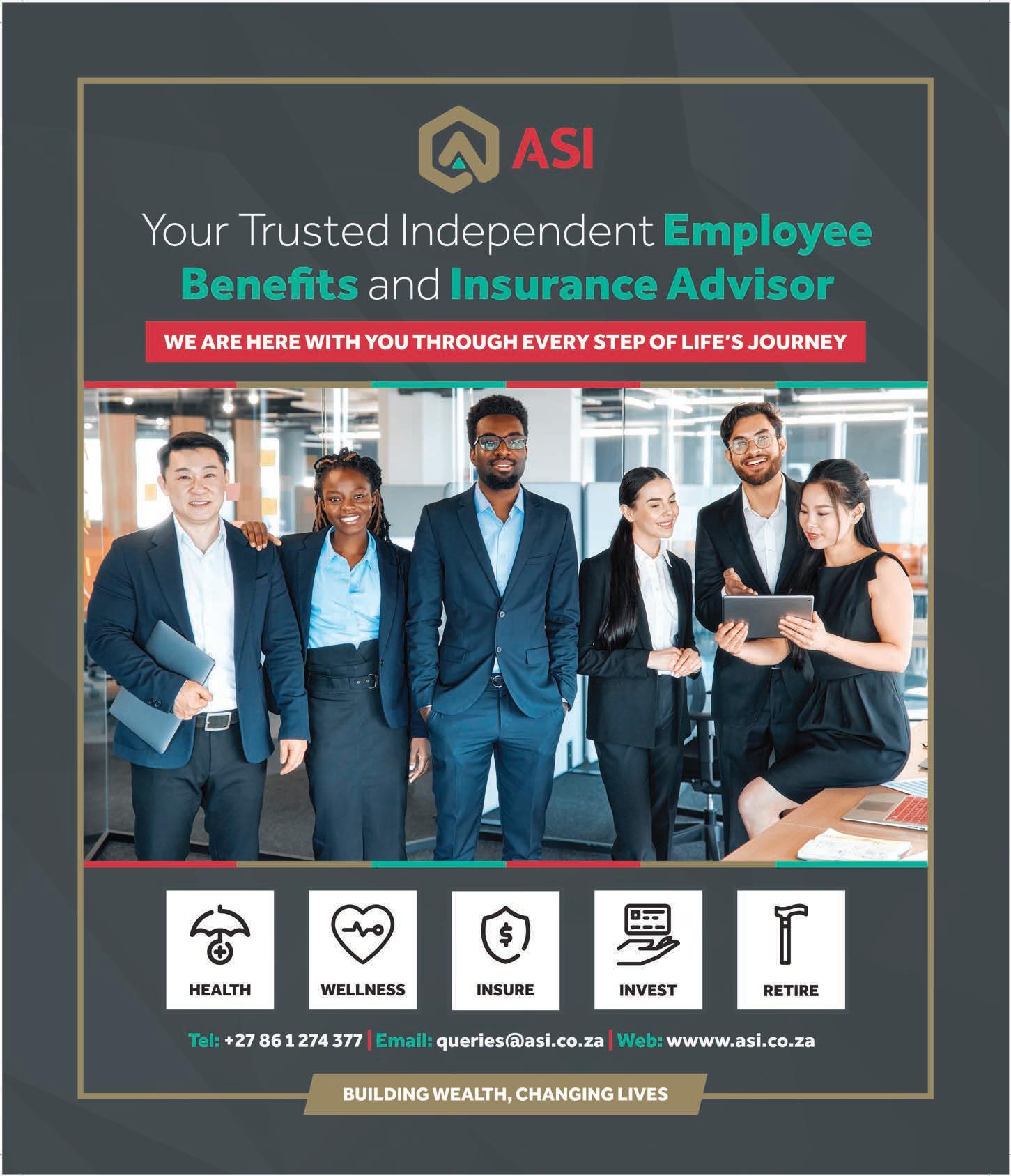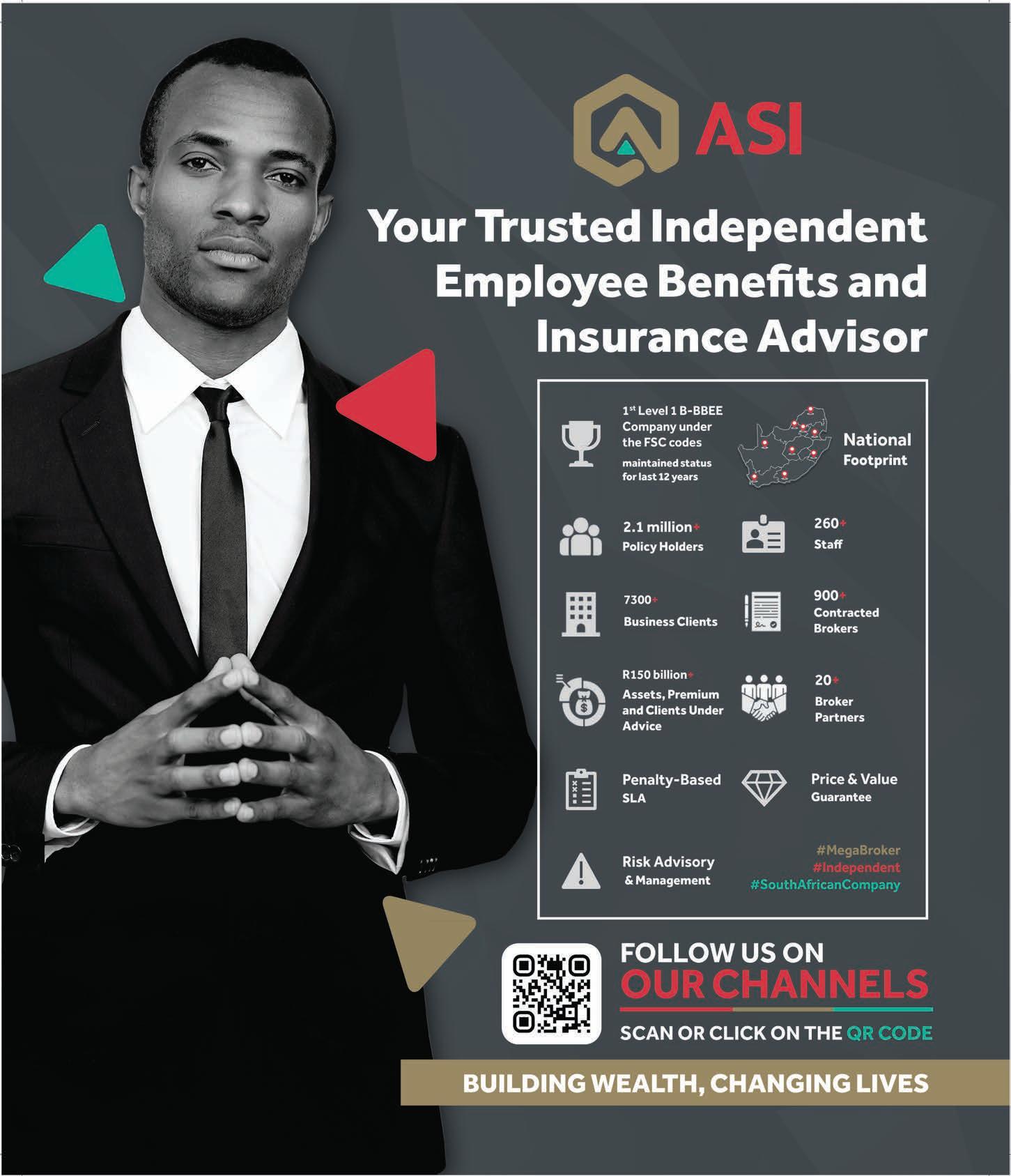
























CREATING THE NEW NORMAL Navigating generational workplace shifts


















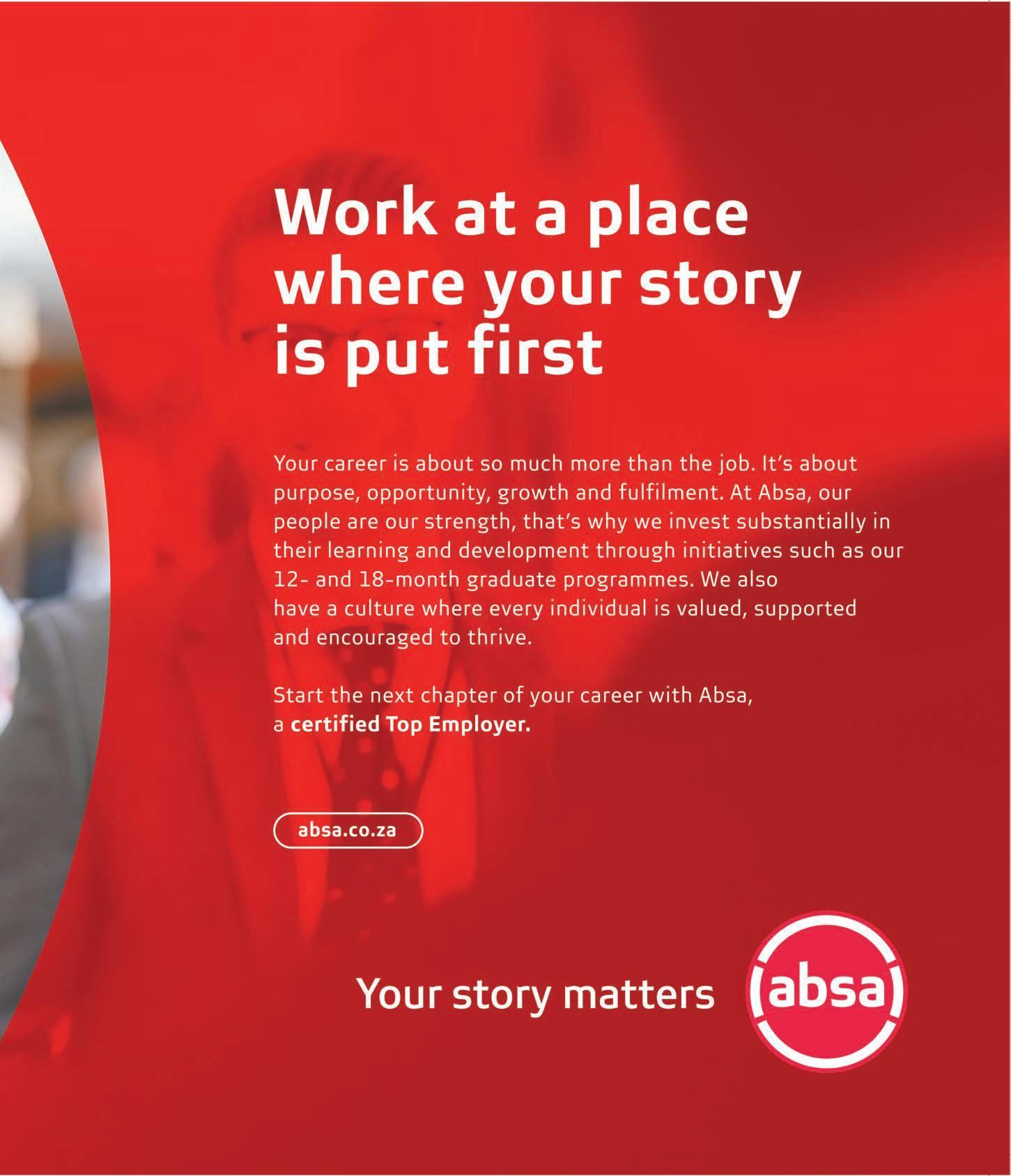

















































There is little doubt that the human resources (HR) landscape is undergoing signi cant change and development, particularly as culture shifts and digital transformation combine to drive forward a new and exciting era of HR.
From a cultural perspective, employees today have new focuses. We also now know that company culture is only strengthened by diversity, and South Africa places a high premium on diversity and female representation throughout organisations, most especially within senior leadership.
A modern workplace needs a diversi ed staff complement that includes employees from different generations – Gen X, Gen Z and Millennials – who each have their own approaches to work and their speci c skill sets. Therefore, recruiting for the modern workplace has vastly different rules and mindsets. Our new normal is not only characterised by more inclusive strategies and spaces, but is also evolving to recognise the importance of the “human” in “human resources”.
In this issue, we share great insights from professionals within the human capital space and hope it raises the right questions and considerations for our new modern workplace.
Rodney Weidemann Editor


24 Employee wellbeing: a changing perspective.
29 Tracing the evolution of remote and hybrid working.
30 Does a lack of team cohesion warrant a return to the of ce?
34 Recruitment – the shift to specialised expertise.
35 Trends – from quiet managing to side hustles.
36 From recognition to revenue:
42 How HR should prepare for the two-pot retirement system; and an opportunity for employers to enhance employee nancial stability.
46 Unlocking the future of work with AI-powered workforce management.
50 Judicious application of digital technologies can lead to much better staff alignment.
51 Social media: is it ethical for employers to navigate your personal pages?
54 Telecommunications: specialised recruitment’s key role in uncovering industry skills.
59 Diversity: the strategies needed to ensure gender equality in the workplace.
60 How to cultivate employee loyalty.
BY
Picasso Headline,
A proud division of Arena Holdings (Pty) Ltd, Hill on Empire, 16 Empire Road (cnr Hillside Road), Parktown, Johannesburg, 2193 PO Box 12500, Mill Street, Cape Town, 8010 www.businessmediamags.co.za
EDITORIAL
Editor: Rodney Weidemann
Content Manager: Raina Julies rainaj@picasso.co.za
Contributors: Simonne Adcock, Jody Eiser, Claire Kedzierski, Vukani Magubane, Rob Mailich, Itumeleng Mogaki, Kinola Pather, Thando Pato, Brendon Petersen, Nicole Sorrell, Evelyn Vanassche, Benjamin van der Veen, Elrina Wessels, Lisa Witepski
Copy Editor: Brenda Bryden
Content Co-ordinator: Natasha Maneveldt
Online Editor: Stacey Visser
DESIGN
Head of Design: Jayne Macé-Ferguson
Senior Design: Mfundo Archie Ndzo
Advert Designer: Bulelwa Sotashe
Cover Images: istockphoto.com
SALES
Project Manager: Tarin-Lee Watts wattst@arena.africa | +27 87 379 7119
PRODUCTION
Production Editor: Shamiela Brenner
Advertising Co-ordinator:
Subscriptions and Distribution: Fatima Dramat fatimad@picasso.co.za
Printer: CTP Printers, Cape Town
MANAGEMENT
Management Accountant: Deidre Musha
Business Manager: Lodewyk van der Walt
General Manager, Magazines: Jocelyne Bayer
COPYRIGHT: No portion of this magazine may be reproduced in any form without written consent of the publisher. The publisher is not responsible for unsolicited material. Human Resourcesis published by Picasso Headline. The opinions expressed are not necessarily those of Picasso Headline. All advertisements/
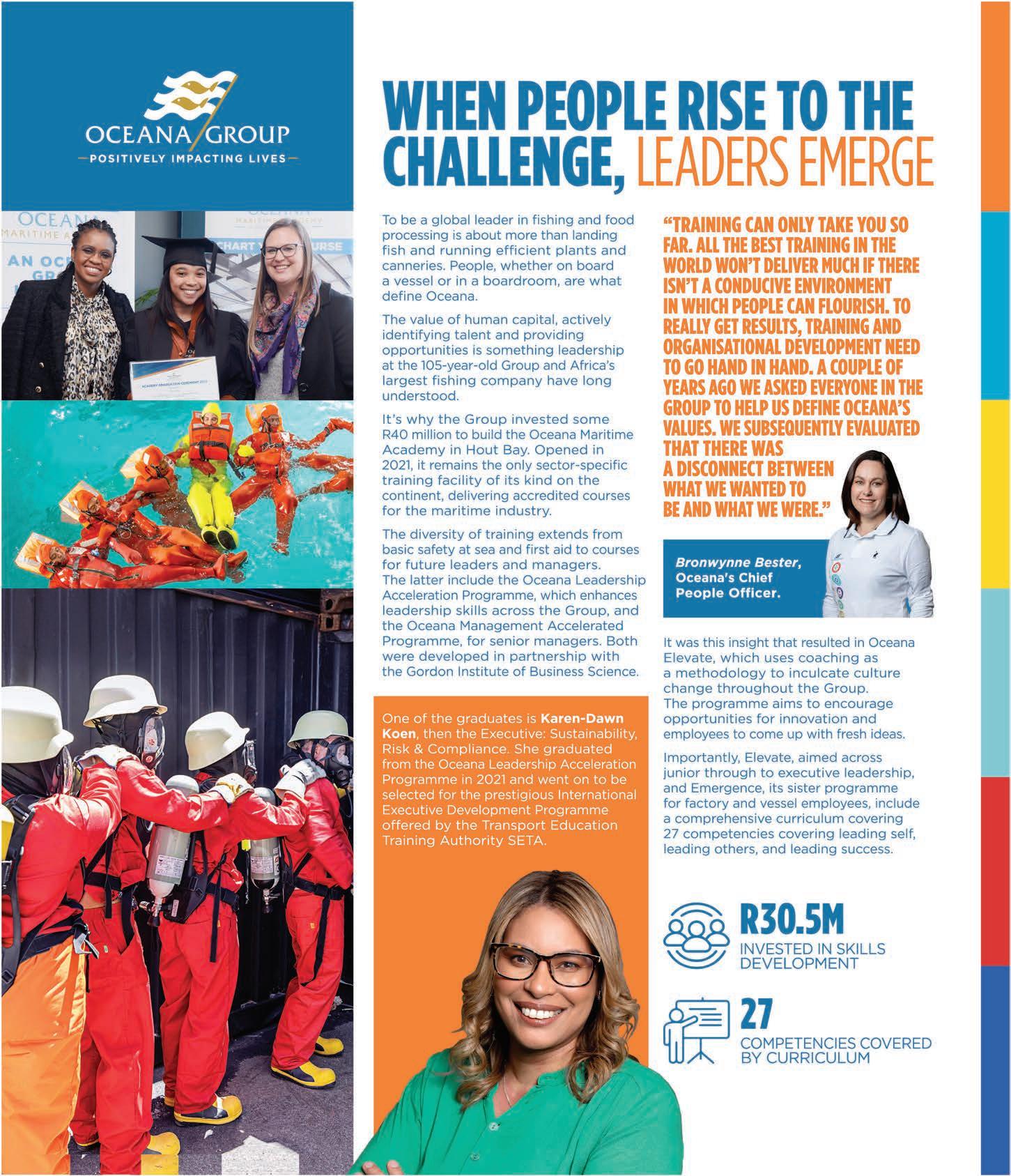
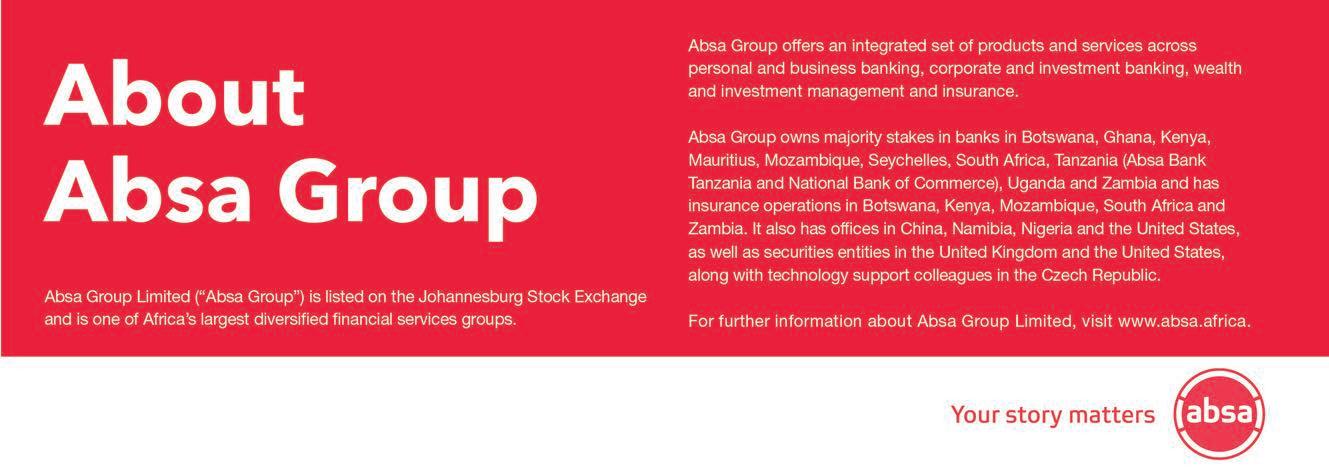
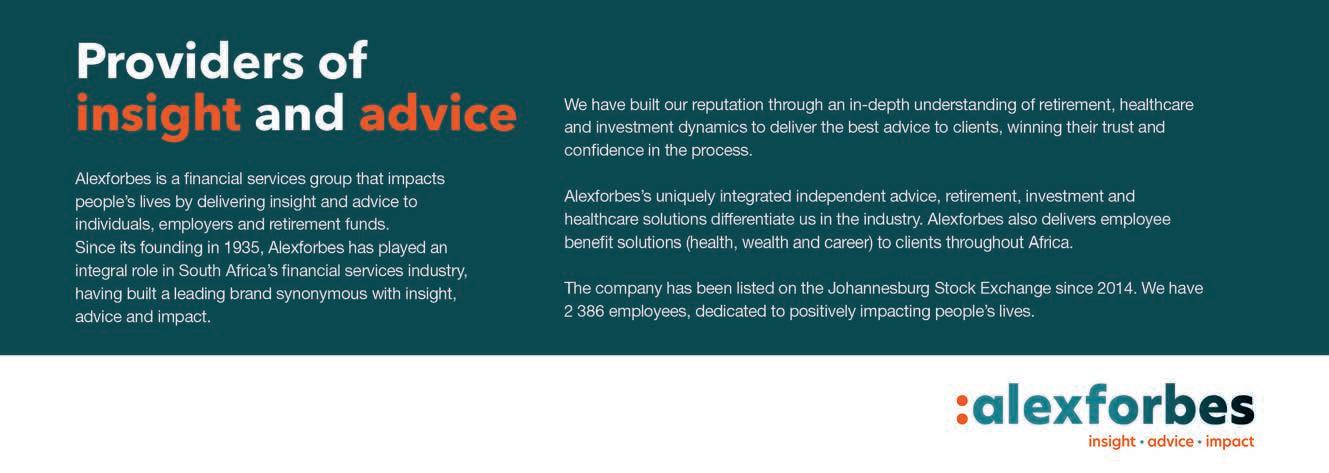
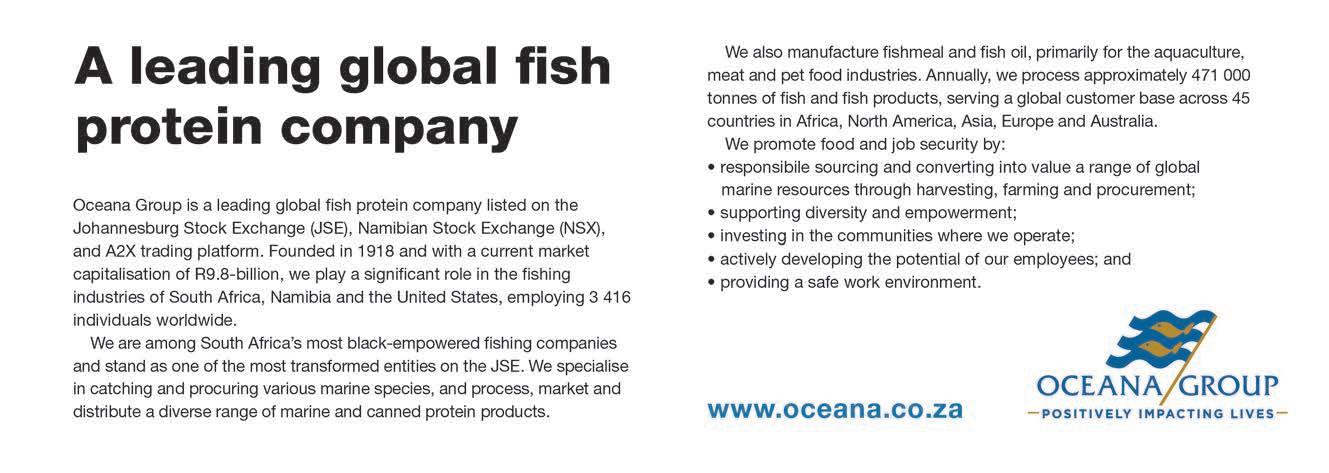


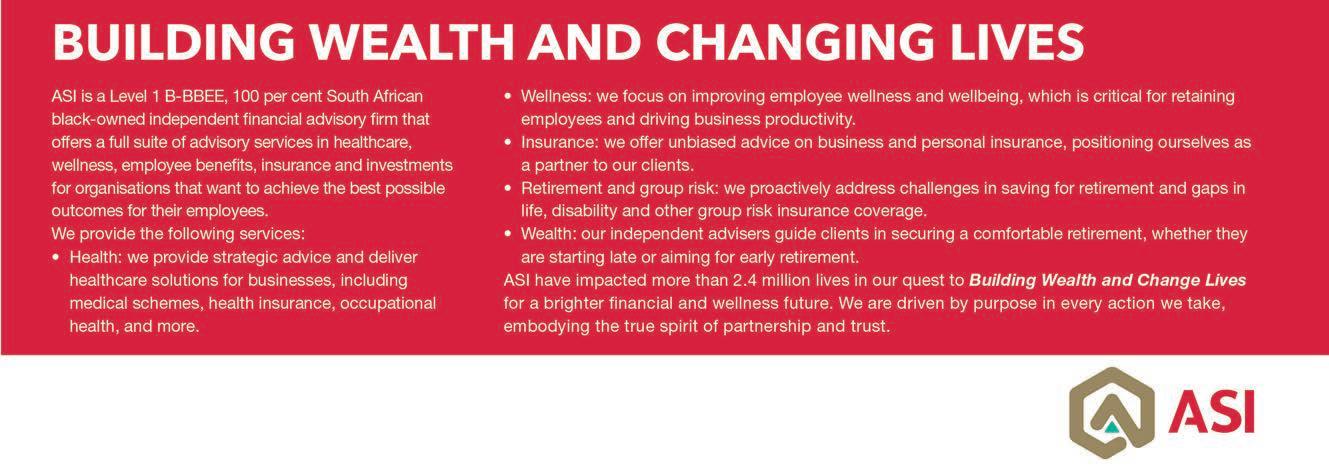

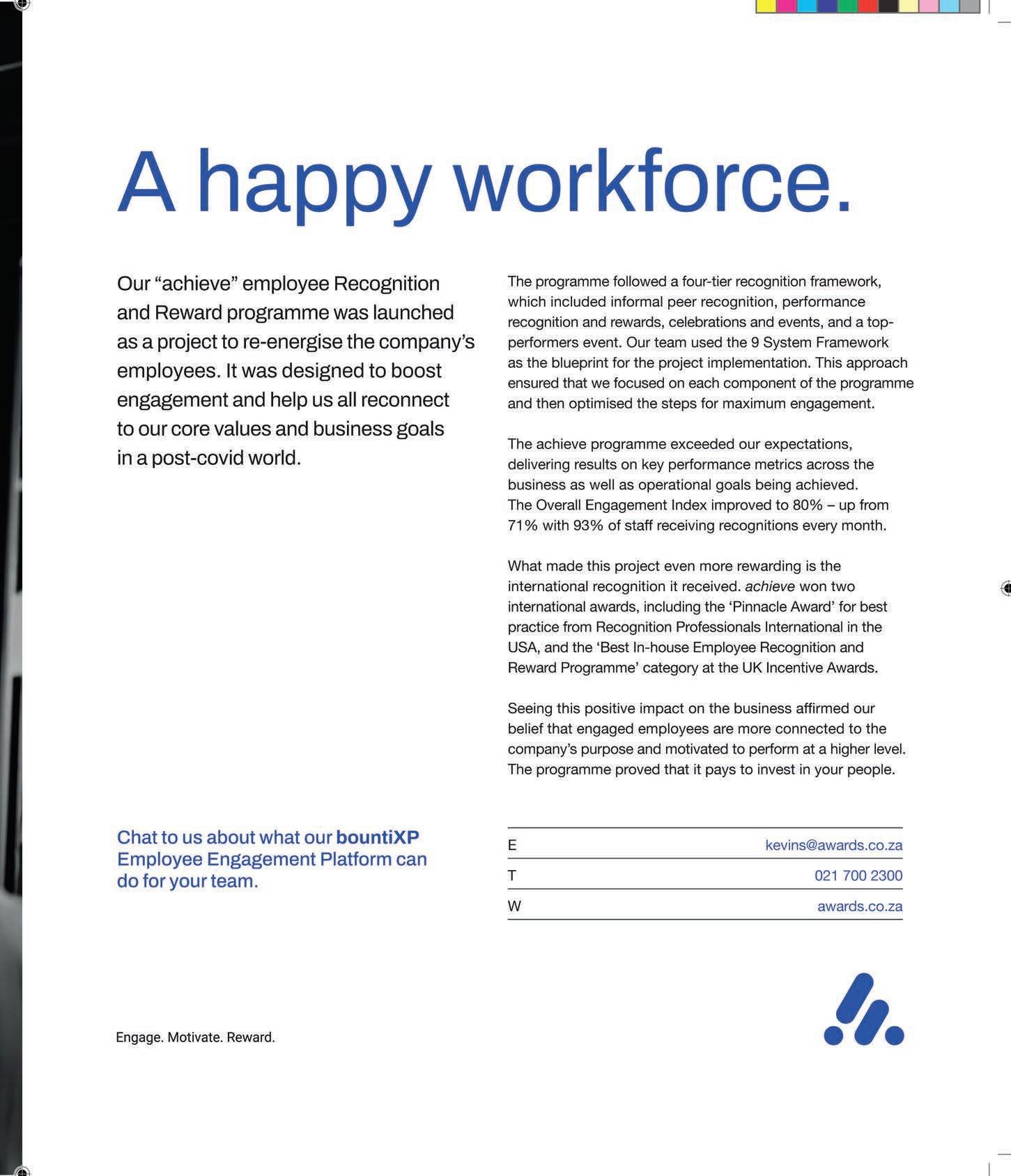

Different generations have different attitudes, and Gen X, Millennials and Gen Z are, in their unique ways, transforming the workplace and the human resources function, writes RODNEY WEIDEMANN
the workplace is a dynamic landscape, constantly evolving with each new generation entering it. Over the past three decades, we’ve seen a signi cant shift in employee attitudes, work styles and expectations, primarily driven by the unique characteristics of the three key generations companies employ: Gen X, Millennials and Gen Z.
This generational shift has not only changed the way we work, but has also necessitated a rapid evolution in human resources (HR) processes to accommodate these diverse needs. Each of these generations brings their unique approach to how they deal with work.
GEN X: THE PRAGMATIC PROBLEM-SOLVERS
Gen X (1965–1982) are known for their independence, adaptability and strong work ethic. They value work-life balance and ef ciency, often seeking out exible work arrangements and opportunities for autonomy.
As Semakaleng Manyike, senior HR manager at Santam, notes: “Gen Xers are hard-working, will do long hours of work and even log into work on weekends. They have attention to detail and are passionate about the work.”
However, their preference for traditional work structures and communication styles can sometimes clash with the more tech-savvy and collaborative approaches of younger
WE’VE SEEN A SIGNIFICANT SHIFT IN EMPLOYEE ATTITUDES, WORK STYLES AND EXPECTATIONS, PRIMARILY DRIVEN BY THE UNIQUE CHARACTERISTICS OF THE THREE KEY GENERATIONS COMPANIES EMPLOY: GEN X, MILLENNIALS AND GEN Z.
generations. HR departments have had to bridge this gap by fostering intergenerational understanding and creating inclusive work environments catering to diverse preferences.
Alexandra Ackron, partner: human capital at the REDi Holbourne Group, adds: “The older generation did not grow up with cellphones, iPads, AI tools or even Google. They seem to be more resistant to change where technology is the focus and it takes them longer to learn it and understand its greater impact on work. The newer generations are more exible, learn quicker and know it as their way of life.”

Millennials (1983–2000) are the digital natives who came of age during the rise of the internet and are often characterised by their ambition, tech-savviness and desire for meaningful work. They value collaboration, continuous learning and work-life integration, often seeking














companies that align with their values and offer growth opportunities.
“Millennials typically seek work that has purpose,” says Joshua Mills, talent manager at Dariel Software. “They tend to be individuals who like to bring in methods or techniques that try to make the workplace more ef cient.”
Their love of remote and hybrid work has been a major catalyst for change in HR policies, forcing companies to rethink traditional of ce-centric models and embrace exible work arrangements. This shift has also led to the development of new tools and technologies to facilitate remote collaboration and communication.

Manyike points out that this group of workers is known to job hop, searching for the next thrill and great opportunity.
“They are hard-working and exible as line managers. This generation generally will allow and encourage work from home, as they enjoy the hybrid work environment, which allows them time to undertake hobbies and to parent.”
Gen Z (2001–2015) are the true digital natives. They grew up with smartphones and social media and are known for their entrepreneurial spirit, social consciousness and comfort with technology. They value diversity, inclusion and work-life balance and are not afraid to challenge the status quo.
“Gen Z adapts to change easily in the evolving world of technology,” says Mills. “They are also open to varying perspectives and value hard work.”
They are expressive in how they dress and speak, suggests Manyike, and are known to be in touch with their feelings, meaning they are not shy to speak up if they feel there is an injustice in the workplace.



“They like to work on short-span projects where there is an end in sight, rather than on long, drawn-out or repetitive tasks. They also enjoy using the company bene ts such as the concierge, employee assistance programmes and wellness initiatives.”
According to KG Bako, managing executive: talent management and transitions at Absa, over the past three decades, HR processes have undergone signi cant transformation to accommodate the entry of new generations into the job market.
“Initially, we focused on traditional recruitment and retention strategies tailored to the needs of Baby Boomers and Gen X employees, emphasising stability, tenure-based promotions and hierarchical structures. However, with the emergence of Millennials and Gen Z, our practices have shifted towards more dynamic and inclusive approaches,” she says.
“These include advertising for jobs using online job boards and professional networking sites such as Women in Tech to tap new talent. In addition, our structures have attened over the years to reduce decision-making layers, while exible work arrangements, personalised career development plans and agile performance management systems where employees get frequent feedback have been introduced.”
This shift, she continues, includes introducing better listening tools to improve employee engagement, work harmonisation initiatives and diversity, equity, inclusion and belonging initiatives to attract, develop and retain talent across generations.
“As a strategic response to the changing needs, preferences and expectations of employees, our HR processes have become more personalised, inclusive and exible to accommodate the diverse workforce spanning multiple generations.”
Bako notes that each generation’s unique thinking stems from various factors, including their upbringing, experiences, societal in uences and their approach to work and problem-solving. The diverse skills different generations possess contribute to the richness of the workplace.
“Gen X employees typically bring strong problem-solving abilities, adaptability to change and a pragmatic approach to work. Millennials excel in collaboration, creativity and technological pro ciency, driving innovation and adaptability within the organisation.

“OUR HR PROCESSES HAVE BECOME MORE PERSONALISED, INCLUSIVE AND FLEXIBLE TO ACCOMMODATE THE DIVERSE WORKFORCE SPANNING MULTIPLE GENERATIONS.” – KG BAKO
By strategically embracing new technologies, fostering a culture of continuous learning and prioritising employee wellbeing, human resources (HR) departments can create an agile and adaptable workforce equipped to thrive in a rapidly changing business environment. This approach not only enhances employee engagement and productivity, but also positions the organisation for long-term success in the dynamic workplace of the future. However, it has not been all plain sailing, notes REDi Holbourne’s Alexandra Ackron. “HR has had to compromise and change its values and incentives. To retain the younger generations, it has had to shift its old-school thinking to flexibility, more leave, remote working and a lot more acclamation and praise. The way the different generations talk and communicate is also different. The working world has become a lot more sensitised or hypersensitive.”
Ultimately, however, the generational shift presents both challenges and opportunities for businesses, she suggests. By understanding the unique characteristics of each generation and adapting their HR processes accordingly, companies can create a thriving workplace that attracts and retains top talent, fosters innovation and drives business success.
“It is important that HR understands that each generation adds a unique dimension to business dynamics. It’s imperative to recognise their diverse strengths and harness their collective wisdom and ways of working to amplify and nurture an inclusive environment for maximum productivity and growth,” Ackron concludes.
“Gen Z individuals contribute fresh perspectives, digital uency, social media infusing energy and forward-thinking approaches into workplace culture,” she explains.
Mills agrees, adding that Gen Xers can be valuable for training younger staff by sharing their experience. They also tend to be hard-working and, typically, are individuals you can count on.


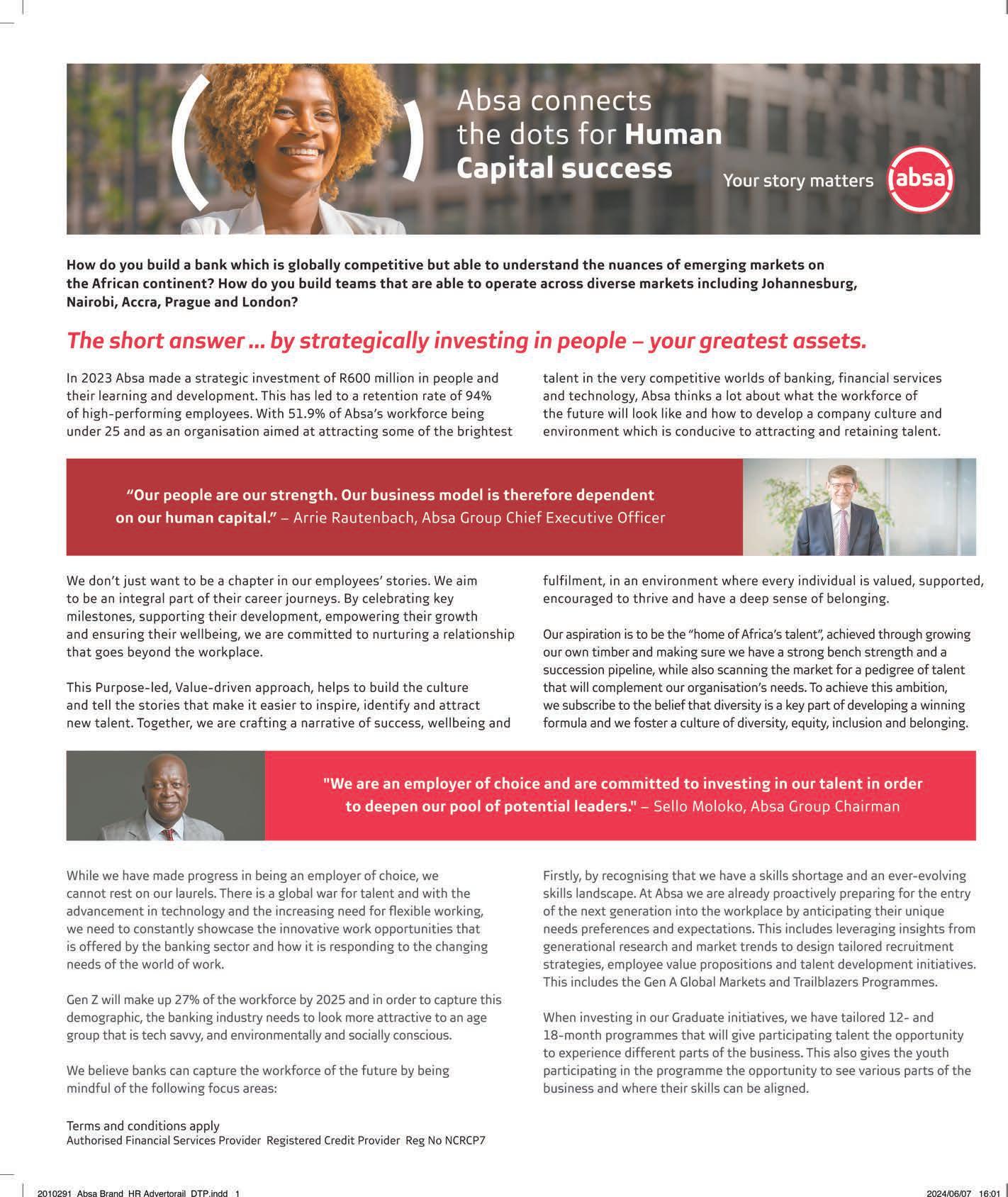
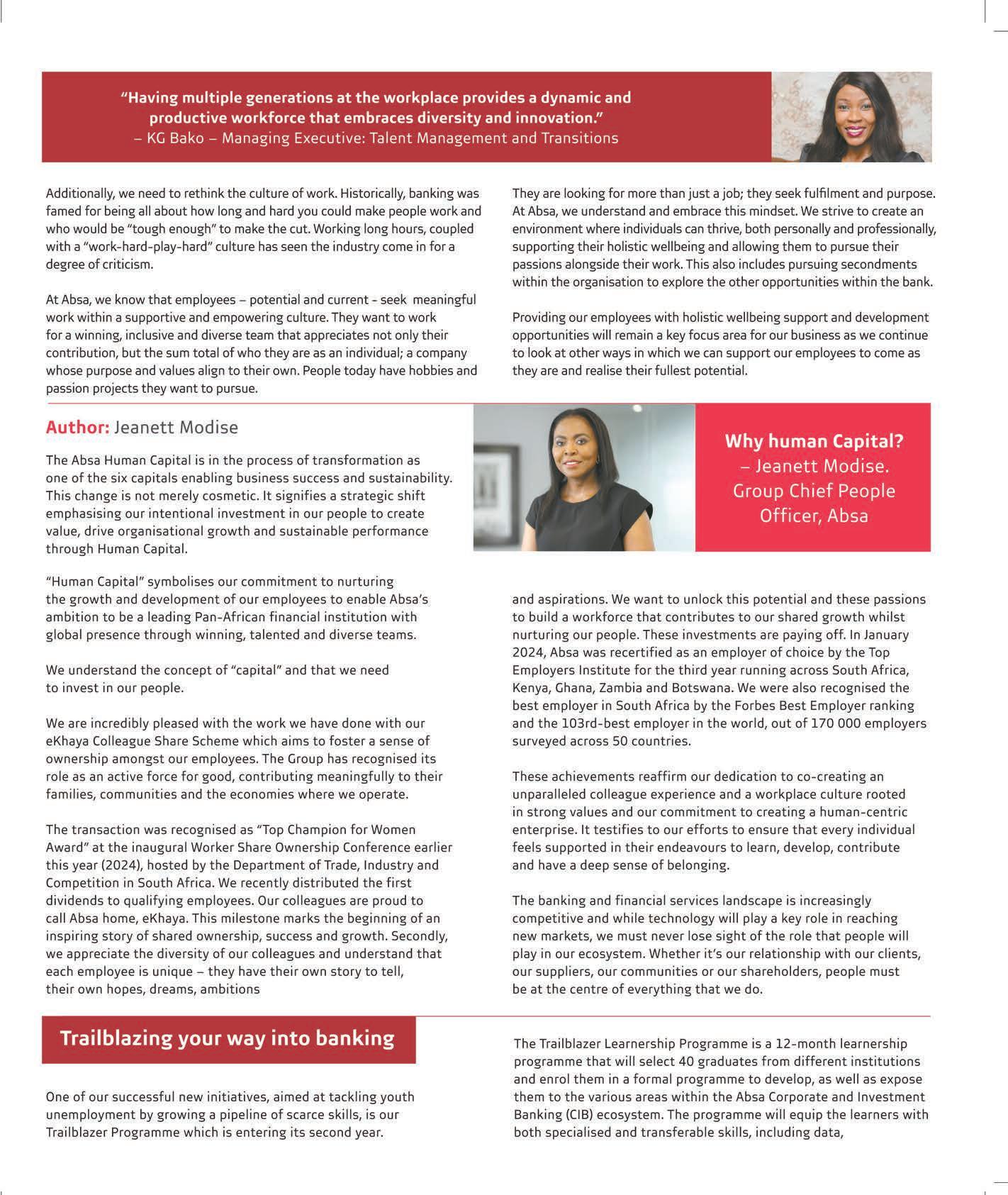
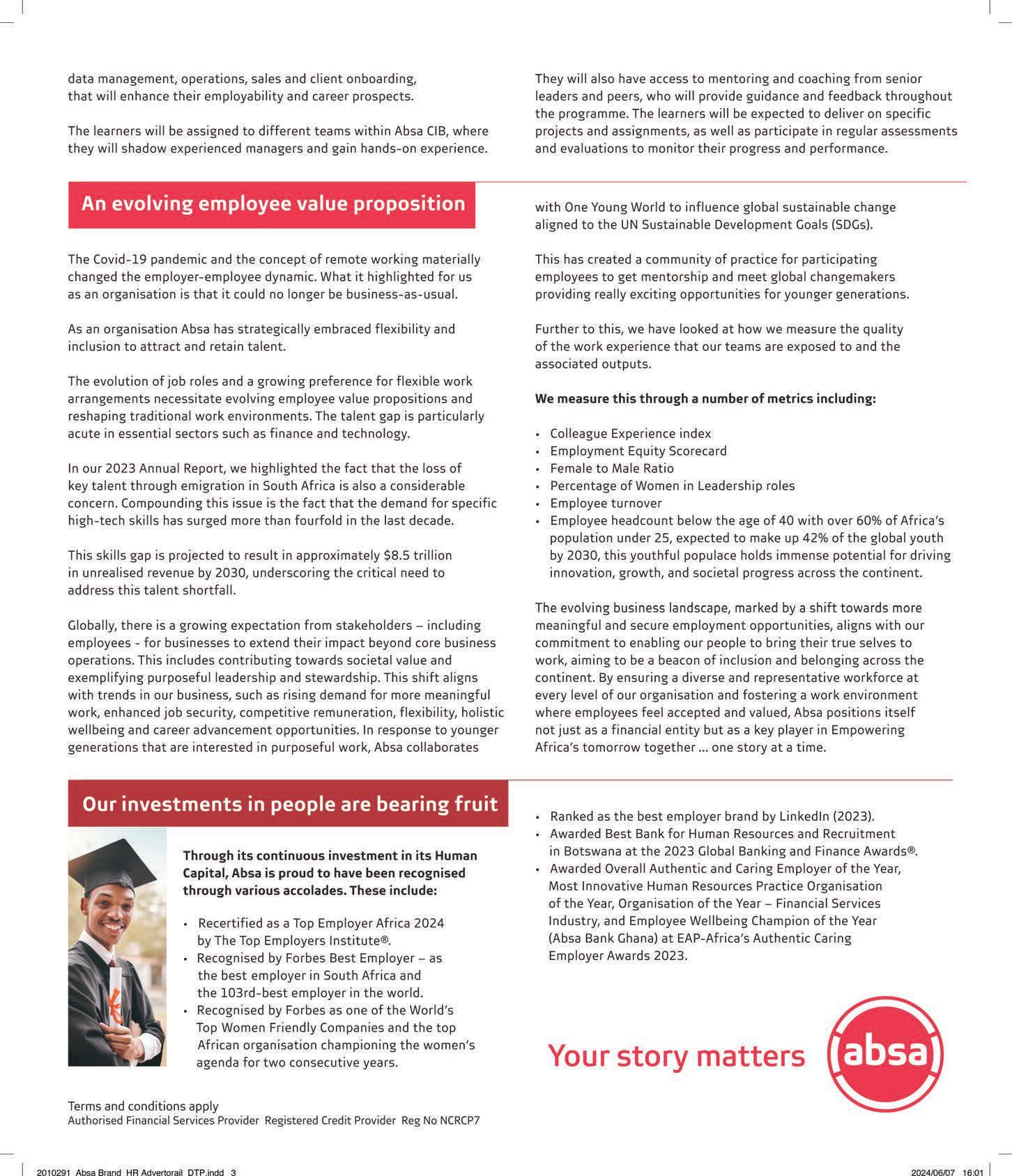
Faced with a challenging local and global economy and a pervasive scarce skills challenge, companies are seeking new measures and tools to help them recruit, motivate and engage their employees,
writes STEVE MALLABY, CEO at adumo PayoutsEmployee incentive and rewards programmes provide companies with a powerful tool to recognise employees, reward outstanding performance, encourage compliance with workplace regulations and augment salaries and bonuses.
The Gallup State of the Global Workplace: 2023 report reveals that 85 per cent of global employees lack engagement in their work. Engaged employees are more productive and customer-focused when they feel appreciated. Driving higher levels of productivity is not the only workplace issue. In industries with high standards for workplace safety, such as mining and manufacturing, employee engagement can be critical to ensuring compliance with safety regulations and maintaining generally high levels of workplace safety.
For companies required to meet high levels of workplace safety, a strategic incentives and reward programme can transform their occupational health and safety capabilities. By building a reputation as an employer offering a safe workplace, companies in high-risk industries can more readily lure workers into their fold.
Effective rewards foster motivation, build loyalty, drive productivity, boost retention and help strengthen relationships between companies and the people that drive their success. Companies seeking to recognise their partners and suppliers for their contribution during the year also bene t from healthier relationships, improved collaboration and stronger partnerships.
Preloaded incentive payment cards have emerged as valuable tools for companies

seeking a rewards mechanism that can meet the demands for personalisation and customer experience. A preloaded incentive payment card, such as adumo Payouts’ Premium Imali card, backed by Mastercard, allows recipients to spend their rewards anywhere that accepts card payments, providing the ultimate in choice and convenience.
In some cases, traditional salary bonuses may be subject to garnishee orders, meaning the employee will not receive the full value of the reward. By providing a preloaded and reloadable incentive card, companies can ensure their rewards programme delivers the optimal experience. When employees (and partners and customers) receive rewards tailored to their needs and aligned with their interests, it demonstrates a genuine understanding and appreciation of their contribution to the company and their role in its success. Giving recipients the freedom to choose the reward they want and to spend it in the way that brings the greatest value to their lives signi cantly enhances the impact of the rewards programme. Companies may conduct

employee surveys to understand whether a cash reward, a travel voucher, wellness package or gift card to their favourite store would resonate best with individual employees. However, this can be challenging in larger companies with dispersed workforces. Using a prepaid reloadable incentive card circumvents these challenges, giving employees the choice of how and where they spend their rewards.
Combining personalisation and exibility ensures rewards programmes deliver employee satisfaction, retention and brand-building bene ts. Effective rewards are essential drivers to attract, retain and motivate employees while building loyalty with customers and partners. By leveraging the power of prepaid reloadable cards, companies can more easily unlock the bene ts offered by rewards programmes.
ADUMO PAYOUTS

Scan to go to adumo Payouts website

For more information: 011 290 9930 stevem@adumo.com www.adumo.com/payouts

The human resources function today is evolving from a process-driven outlier to a people-centred strategic partner getting C-suite attention, writes VUKANI MAGUBANE
The Human Resources (HR) function has been in the “eye of the storm” that has turned the world of work upside down forever, changing how we view work and the employer and employee dynamics.
From its humble beginnings focusing on admin and transactional duties relating to people affairs, it is evolving into a strategic partner for businesses to manage not only talent, but also new ways of working, changing generational expectations and the endless disruptions technology brings to the workplace.
The past few years have brought about seismic challenges for organisations and the HR function. Where we work, how we work and why we work have all changed fundamentally. This has brought about challenges and opportunities for companies to differentiate themselves and for HR to pivot and reshape how it is perceived and how it demonstrates its value.
Some leading experts share their views on how the function has changed over the past 30 years and highlight some of the signi cant changes that have reshaped and rede ned how we manage and lead a company’s human capital.
HOW EMPLOYEES EVALUATE EMPLOYERS HAS MARKED A SIGNIFICANT CHANGE IN HOW HR AND ORGANISATIONS ATTRACT AND RETAIN TOP TALENT.
Dr Dieter Veldsman from the Academy to Innovate HR (AIHR) says the function has “de nitely transformed and evolved” from what he calls the “hire-and- re” era, when HR did not exist for employees, but rather for employers. In today’s strategic era of HR, the function has moved out of pencil pushing to “how can we translate the human agenda/strategy” to business needs and objectives.
Dr Veldsman, a former chief HR of cer (CHRO) at Momentum Metropolitan, is currently chief scientist, HR and organisational design, and a thought leader at the Netherlands-based online academy. He describes AIHR’s mission as future-proo ng HR through world-class online training programmes for HR.
He says in the past, HR has carried a lot of baggage about how the function operates and has been criticised for not understanding the business, which is a misconception. In this era of
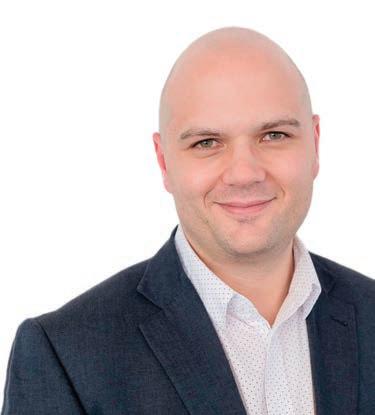
a more strategic HR function, he explains, its role is to present and voice the people’s agenda in the context of the business strategy.
Dr Veldsman cites the changing scope and role of the CHRO – driving talent management and the people agenda – as providing more credibility to the function and a seat at the table with other decision-makers.
The skill set required now focuses on the future of leveraging technology and incorporating data into decision-making: how do we understand people as human beings? What motivates them? Having the data from HR to answer these questions is a strategic and critical need for business as it highlights the employer-employee relationship and helps create the right culture for business success.
He adds that HR needs to facilitate the discussions around the big issues such as arti cial intelligence and how it impacts the world of work and purpose and must be the champion of these discussions that are rede ning and reshaping how people are managed and led.
Dr Dayalan Govender, PwC Africa’s people and organisation leader, says COVID-19 was a “wake-up call”. He explains that purpose has become an element young people seek when looking at prospective employers. They ask “what have you done as PwC?” There has been a mindset change. Loyalty and climbing the career ladder are no longer the drivers. As for longevity? This group add value for three years, he says, and then want to spread their wings and be agile.
These signi cant changes in how employees view work and purpose, and what the employer does – not only for them, but also society in general – has had a knock-on effect on HR’s role. How employees evaluate employers has marked a signi cant change in how HR and organisations attract and retain top talent. Technology has also had an impact. There is a more robust war for talent. Post-COVID-19 exibility and hybrid are the norm.
HR has had to be more exible and agile to keep up with these changes.
The focus on wellbeing post-COVID-19 is an urgent people issue for the HR function to champion. People are burnt out, Dr Govender says, highlighting that senior leaders’ wellbeing should not be overlooked.
The push by employees to be seen as a whole person at work, rather than just an employee number, highlights another shift HR has had to embrace as diversity, equity and inclusion (DEI) has become a focus for more organisations.
“There is huge emphasis on having a diverse workforce so that the organisation is resilient. Belonging is also important because it is a factor in being engaged and feeling as though you are part of a family, given the amount of time people spend at work,” adds Dr Govender.
The employee experience is now a strategic focus for leadership. People are central in getting a competitive edge in the marketplace. Employee experience and culture are critical in driving employee engagement and productivity.
“HR is the custodian. The function has to guide leaders in driving the behaviours that are consistent with the culture and values that will sustain success,” Dr Govender says.


Dr Govender says gig work and contingent workers who have highly sought-after skills, such as data analytics, work on a project and then move on, but are nonetheless making demands that suit their personal needs –another signi cant change facing HR.
Kgomotso Mopalami, head of professional solutions and business at the South Africa Board of People Practices (SABPP), a professional body for HR practitioners, says South Africa is buying into the model of HR being strategic. Technology, she adds, has revolutionised HR to streamline the administration tasks.
She adds that the HR model has become more complex and includes business knowledge, ethics, professionalism, duty to society and governance.
Mopalami says some signi cant changes impacting HR include:
• partnering with business and being embedded so it can play an advisory role, coach and be a mentor;
• technology integration;
• greater focus on people and the employee experience; and
• a move away from being inward and focusing on administration and processes. “It pains me when people think of HR as an admin function,” she adds.
Tesantha Naidoo, principal consultant at Mercer Africa, says HR was seen as a “hero” for its role during the pandemic, when the mental health of employees took a big knock and there was a magni ed lens on mental health.
“If it weren’t for HR, many employees would not have made it. Getting people the right equipment to work during COVID-19 highlighted the importance of HR to the C-suite,” she explains.
Naidoo also cites the employee experience, which she de nes broadly as looking at the employee value proposition, career, wellbeing, compensation and even asking if everyone is getting a fair wage. Are people losing sleep (because of nancial concerns)? If they are, it impacts them at work, she says.

Naidoo also says a signi cant shift worth noting is the change in the calibre of HR heads, who now come from different backgrounds, meaning they bring a different way of thinking about the function.
“Heads of HR are no longer just from traditional HR backgrounds. Boards are looking for a different way of thinking to lead HR. Shareholders are looking at people, environmental, social and governance,” she says. “Also DEI and transparency. Boards have to answer to investors, and shareholders have vested interests in both people and people practices, which is very positive.”
Ultimately, however, Naidoo and the other experts are very optimistic about the future of HR and its evolving role. “There has been such an evolution, it is ongoing, and it’s very exciting,” she concludes
THE HR MODEL HAS BECOME MORE COMPLEX AND INCLUDES BUSINESS KNOWLEDGE, ETHICS, PROFESSIONALISM, DUTY TO SOCIETY AND GOVERNANCE.


GOVENDER , chief visionary officer, ASI Financial Services, introduces the six principles for developing a strong employee value proposition during tough times
Over the years, the South African employee bene ts landscape has witnessed signi cant shifts. For instance, the number of retirement funds available to choose from has dwindled from just over 15 800 in 2000 to around 5 000 by 2020. Similarly, medical schemes have also transformed – their numbers decreasing by over 50 per cent in the past two decades. This has signi cantly increased average contributions, making private healthcare affordability a challenge for many employees.
We are currently undergoing a monumental change to the legislation governing our two most established and well-funded “employee bene t options”, namely, medical schemes and retirement funds. There will be some fundamental changes, the proverbial good, bad and ugly, if you will. What this means for organisations is that we need to be open to some radical changes to the traditional bene ts model. As you may be aware, on 15 May 2024, President Cyril Ramaphosa signed the bill into law in South Africa and on 16 May 2024, it was gazetted as the NHI Act, but no effective dates have been stipulated as yet.
Even though the silver lining here is the emergence of more affordable, sustainable and equitable private healthcare and retirement savings mechanisms, expecting human resources (HR) professionals to be con dent advisers for these new products, their implications and how they t into legislation that has yet to be written is shortsighted and has created a large amount of unease across the board. This highlights the need for HR teams to consider partnering within and outside the business, to bring expertise and comfort through a change process.
To build a resilient employee value proposition (EVP), employers must navigate tough times and offer a fresh set of bene ts encompassing both traditional and modern approaches, loyalty initiatives and the six principles outlined below.
The foundation of a strong EVP lies in an organisation’s culture, which attracts employees whose values and aspirations align with the company’s. While social security and practical needs are important, employees seek a sense of belonging, fair treatment of customers, the value offered to society and the opportunity to be part of winning teams.
According to a study by Gartner, the future EVP must encompass ve key factors: deeper connections, radical exibility, personal growth, holistic wellbeing and shared purpose. Additionally, at ASI Financial Services, we believe that a robust EVP in tough times should also include elements such as time and leisure, travel opportunities, education and development, loyalty programmes with tangible bene ts, mental and emotional wellbeing support and avenues for employees to give back to the community.
5. Mental and emotional wellbeing. Support employees’ emotional wellbeing, which leads to increased productivity and a stronger connection to the company, even in the face of adversity.
6. Giving back and making an impact. Create mechanisms for employees to actively participate in charitable endeavours and make a positive difference, fostering a sense of purpose during challenging times.
An integral aspect of a strong EVP during tough times lies in providing nancial coaching and independent nancial planning to every employee on the payroll. This goes beyond offering traditional bene ts, as it empowers employees to make informed nancial decisions and improves their holistic wellbeing. Equipped with nancial knowledge, employees gain a deeper understanding of the risks and rewards associated with their nancial choices, leading to better nancial management and long-term goal achievement.
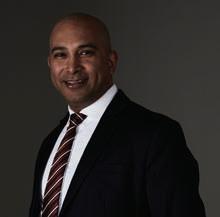
As a result, we have identi ed six principles to guide employers when shaping a strong EVP for tough times.
1. Time and leisure. Implement reward programmes that promote relaxation and offer employees the chance to unwind, even amid challenging circumstances.
2. Travel. Provide opportunities for work-related trips to spark inspiration and foster growth, encouraging employees to embrace change and exploration.
3. Education. Offer continuous learning opportunities to employees and their families, empowering them to thrive in a rapidly changing world.
4. Loyalty and value. Design loyalty programmes that offer tangible bene ts, providing employees with a sense of security and peace of mind during turbulent times.
By making nancial coaching an essential part of the EVP framework, businesses demonstrate their commitment to their employees’ nancial wellbeing, providing them with the tools needed to navigate the challenges of today’s dynamic nancial landscape successfully.
As South Africa faces tough times, a strong EVP is pivotal for organisations seeking to weather the storm and emerge resilient. By embracing a robust EVP and partnering with advisers to embrace change and empower employees through nancial coaching, businesses can attract and retain top talent, fostering a motivated, engaged workforce with an EVP ready to take on these tough times.
The reality is that traditional EVPs must undergo a fundamental makeover to adapt to factors such as shifting legislation, evolving employee sentiments, changing buying trends, personal values and technological advancements. As we navigate through tough times, a strong EVP becomes even more crucial to attracting and retaining top talent and fostering a resilient, engaged workforce.
No two EVPs are identical, as they encompass everything from the general culture of a company to the traditional bene ts offered. At ASI Financial Services, we can help you craft a robust employee value proposition that can thrive amid uncertainty while meeting the changing expectations of a transformed workforce. Images: Supplied





work-life balance and personal growth and development. They want to work where their individual needs are supported and met. Leadership also matters – they want to work for leaders they respect and who run ethical companies – and this is not just a nice-to-have, but rather a must-have.
“A company is being judged not only on what it is doing for shareholders, but also how it impacts all its stakeholders. They are asking: ‘what value does your organisation play in CSI. How are you responding to your stakeholder groups?’,” Tager adds.

Employees today are not merely looking to build careers, but to have the ones that have value and purpose within a company that aligns with their values, writes VUKANI MAGUBANE
There was a time in days gone by when the promise of lifelong employment, with all its rewards and perks, such as a paycheck to cover your bills and a ladder to climb if you were ambitious, was the main reason to go to work.
As you hit your longevity markers of ve, ten and more years, you looked forward to the lunch with colleagues, praise from your manager and a gift of a plaque or gold watch from human resources as a thank you.
Yes, money and bene ts still matter. However, employees today expect a lot more from their relationship with their places of work. Millennials and Gen Z are leading the way – and companies are paying attention.

Nicola Tager, head of careers and employee experience at Investec, says employees today are looking for a workplace whose values are in sync with their own, along with personal growth, development and exibility.
“These generations are looking for the interconnection between their values and the
values of an organisation, and they will not work for an employer whose values jar with their own,” she says.
“Gen Z takes values even further, emphasising ethics, asking whether the company is doing the right thing in terms of corporate social investment (CSI), purpose and the planet. Talent is not only selecting on salary and bene ts, but also on these new expectations,” Tager explains.
Both generations want to grow professionally and value learning, but for different reasons. Millennials value learning for career growth, while Gen Z wants to keep up with the rapid changes brought by technology.
Tager says companies are listening to what the new generations want. Employee experience and employee value propositions are more strategic for an organisation now, and people’s lived experience is what attracts the best talent.
Employees are voicing what matters to them. They want to be viewed as a total person, which includes their mental health and wellness,
Bronwynne Bester, chief people of cer at Oceana Group Limited, a global shing and food processing company, says this is especially true in the shing environment. What is happening in the ocean is a concern and the newer generations ask questions.
“It comes up naturally in conversations with prospective employees,” she says. “It has become an imperative – we must actively demonstrate what Oceana is doing in our environment.
“It is hard to attract people to shing. A sustainable shing environment is important to us. The company takes sustainability seriously – this is embedded across the organisation and demonstrated in our commitment to ensuring shing resources are stable,” she adds.
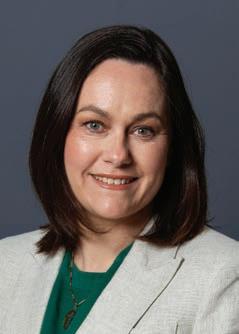
In a “show-me don’t-tell-me” era, Oceana is doing its part in detailing its good corporate citizenship. It takes pride in supporting small-scale shermen and food security in needy communities.
“We have a tangible and solid demonstration of how we are positively impacting lives (which is the company’s brand promise),” she notes.
Purpose, health and wellness, work-life balance, integrity, diversity, inclusion and belonging, as well as the principle of “see me as a human being” are today not merely the latest HR buzzwords; they are the non-negotiables that can decide if that top talent says yes to your offer letter or politely declines.
“EMPLOYEES TODAY ARE LOOKING FOR A WORKPLACE WHOSE VALUES ARE IN SYNC WITH THEIR OWN, ALONG WITH PERSONAL GROWTH, DEVELOPMENT AND FLEXIBILITY.” – NICOLA TAGER
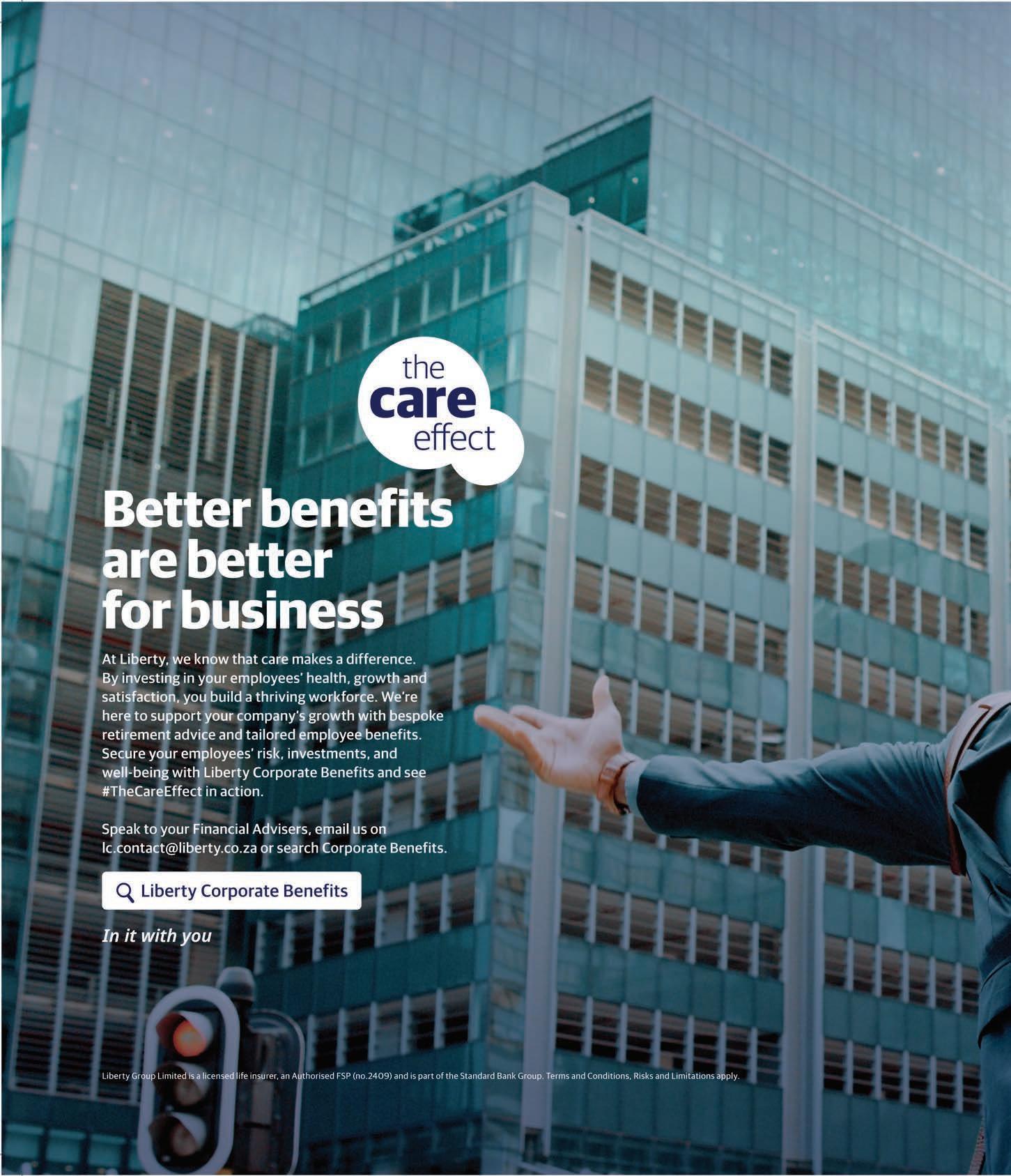


Employers’ attitudes towards the wellbeing of their staff are undergoing a significant shift. LISA WITEPSKI outlines the changes
Previously, any company offering an employee wellness programme could pat themselves on the back: beyond offering a hotline and establishing why and how long an employee needed sick leave, little more was required.
Today’s outlook is vastly different, says Vinolia Singh, chief people of cer at the Adcorp Group. She maintains the shift began during the global economic crisis of the early 2000s, which prompted employers to consider their employees’ nancial wellbeing and physical health. Unsurprisingly, however, it was the COVID-19 pandemic that encouraged them to take a more holistic view.
“We now think of wellbeing – which is multidimensional and incorporates nancial and, increasingly, mental health – instead of wellness. We think of everything a person might bring to work with them, and that means their personal issues, too,” she says, adding that this often means that an
organisation’s wellbeing offering extends to an employee’s family members.
At the same time, the approach to wellbeing has become more customised, Singh says. This has been prompted by the acknowledgement that there are now ve generations sharing a workplace – each with very different expectations, needs and priorities.
That said, some issues are common across the workforce. First is the lack of work-life balance: something that was always a struggle was heavily impacted by the pandemic. This has left a legacy of “boundarylessness”, with our WhatsApp groups becoming an extension of email and ensuring we are always switched on.
Added to this is the pressure of caring for family members – children and parents – which contributes to a third prevalent phenomenon: overwhelm.
“CORPORATES WOULD ALSO DO WELL TO LOOK AT HOW THEY CAN ACCOMMODATE THE NEEDS OF NEURODIVERSE EMPLOYEES.” – DR CHRIS VAN STRATEN
Dr Chris van Straten, global health advisor on corporate governance at International SOS, agrees with the observation that many effective solutions involve customisation. His job is a case in point: he was both a musician and a highly quali ed doctor until a meningitis infection left him profoundly deaf.
“As a person who was once super-abled and is now disabled, I can see that there is no such thing as a one-size- ts-all work environment. For example, although most humans are social beings, some of us need quiet spaces to be at our best.” Fortunately, he says, the hybrid work models that have become common since the pandemic help accommodate most preferences.
Corporates would also do well to look at how they can accommodate the needs of neurodiverse employees, adds Dr van Straten, while further exploring ways to minimise stress.
“Many companies nd introducing services such as an in-house clinic address anxiety because employees might feel judged for taking time off to see a doctor, but this facility makes healthcare more accessible. Simply put, it’s about making life easier.”
Of course, such offerings come at a cost – which is where technology plays a role. Apps that allow for online


health consultations are a great time (and money) saver. Dr van Straten has even seen the introduction of apps that track factors such as mood and allow for immediate connection with a chatbot for those struggling with issues such as depression, with excellent results.
Michelle Ward, talent manager at Bestmed Medical Scheme, says the process of helping employees improve work-life balance is ongoing, requiring continuous adjustment.
“We embarked on a comprehensive research and consultation programme to
Six in ten participants in the Talent Trends Africa 2023 Report prioritise work-life balance and mental wellness over career success.
Source: Talent Trends Africa 2023 Report
develop a exible hybrid environment in the post-COVID-19 world,” Ward informs.
Features of this programme include 24/7 support services encompassing emotional counselling and nancial and legal support, wellness days and team days, which include activities to foster connection. Regular feedback sessions have been implemented to

Employee assistance programmes enable staff to get help when they need it, as well as allowing them to improve their quality of life, writes RODNEY WEIDEMANN
Damien and Christine Seid, co-founders of Company Wellness Solutions, point out that according to Ford’s 2024 Trends Working For Balance Survey, around 60 per cent of millennials in the United States were prepared to take a 20 per cent pay cut “to achieve a lifestyle that prioritised their quality of life”. Internal research done locally, the pair continue, indicates that this figure also accurately represents the attitude of millennials in South Africa. They contend that this therefore necessitates a “comprehensive wellness programme that encompasses what is
“Corporate
wellness interventions
understand employees’ changing needs and amend policies accordingly.
“Focusing on holistic employee wellbeing isn’t about increasing productivity or the bottom line. It’s really about creating shared value that encourages and supports employees, who feel safe and are given the tools they need to thrive,” Ward concludes
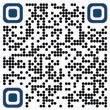
What this means for employers, note the Seids, is that if they want to attract and
traditionally known as an EAP (Employee Assistance Programme) as well as a comprehensive, proactive, technology-based solution that will enable employees to get help when they need it, as well as allowing them to improve their quality of life, with tools to track and monitor both physical and emotional wellbeing”.
“Our own EAP offers multiple avenues for an employee to get in touch with an expert via a toll-free line, USSD, website or native application. Counselling, legal advice, debt advice, fitness and nutrition advice and medical help are all important aspects of this wellness programme.”
need to grow
and
adapt.” – DAMIEN AND CHRISTINE SEID
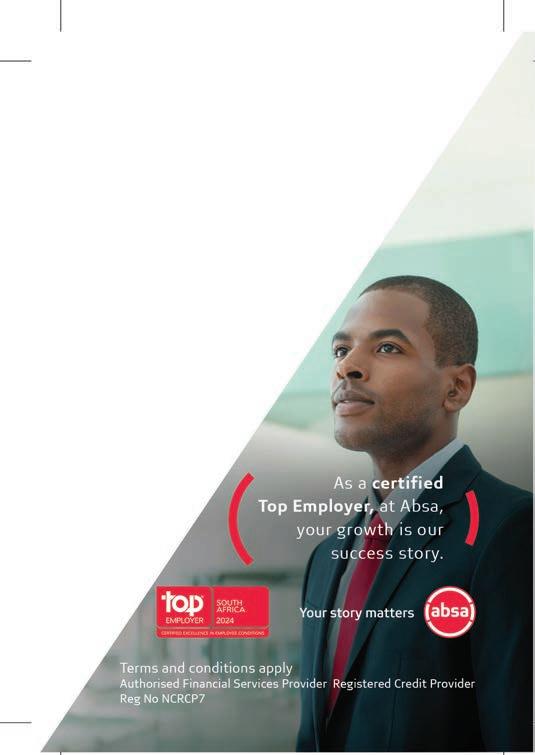
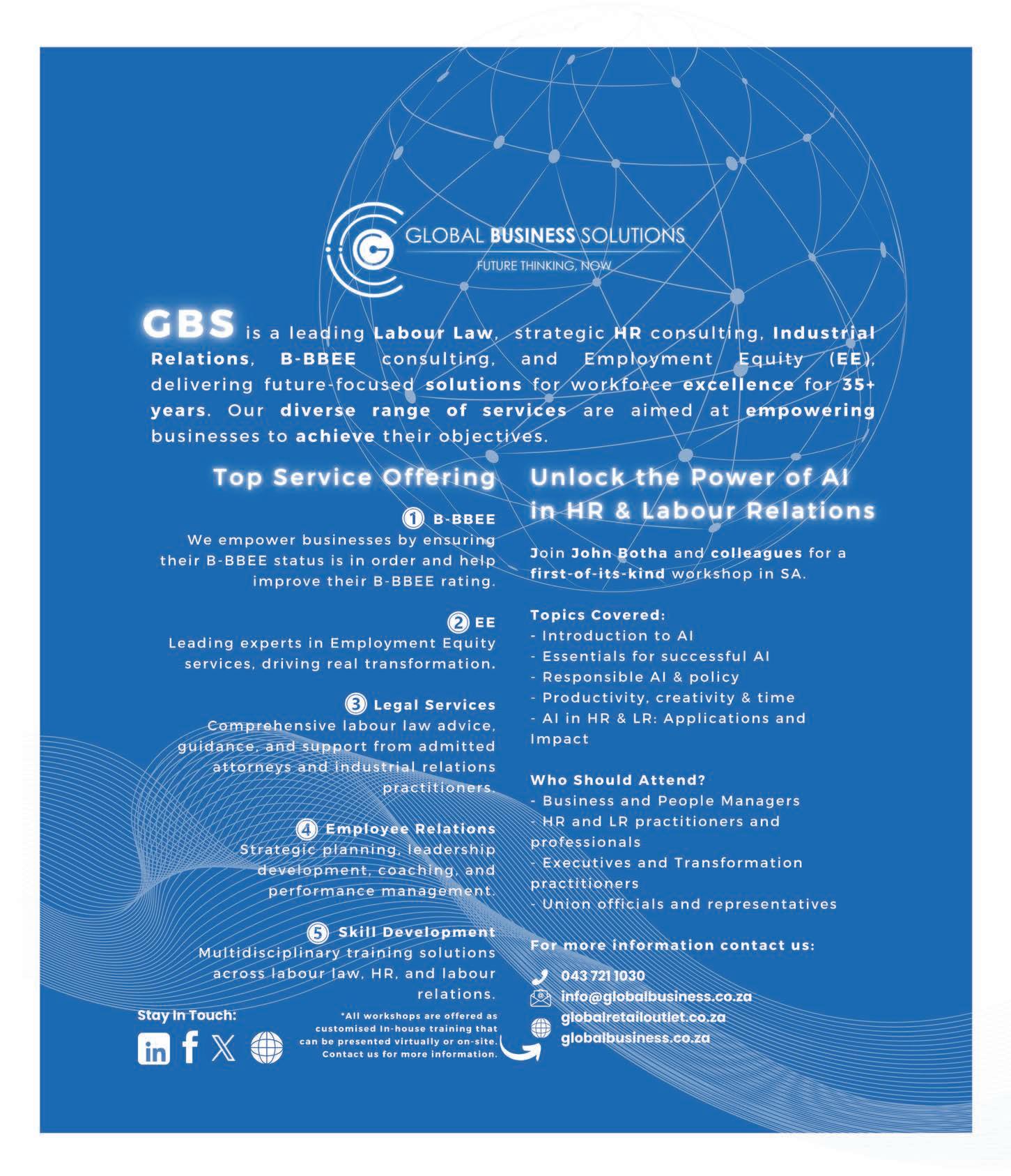
How leveraging behavioural and data science helps companies to understand and engage with their employees. By
MELISSA RAM SAM Y-AGAPITUS, executive: Group Risk and Investment, LibertyWe live in a connected, online world where mass data is constantly formed by countless human interactions daily. This gives us plenty to think about. For human capital professionals, looking for direction to help determine the future needs of employees’ risk cover and long-term investment requirements, these kinds of insights need to be more nuanced and long-term focused.
This current cycle of national political elections has demonstrated that change is constant, as voters seek new options for what they perceive as key issues in their lives.
Unlike voters in a democracy, employees don’t cast ballots, so to meet their nancial and emotional wellbeing needs we must look at all-encompassing political and environmental trends and ascertain how these can affect a product like group risk and umbrella cover, which offers them a broad range of solutions to manage their futures.
Liberty is in the business of managing long-term risk and this enables us to give our clients the best possible outcomes on their road to retirement. To do this, we constantly examine a variety of local and global factors that come together to in uence the world in which we live. In looking at these outcomes, we note several key trends that will affect all our lives. These factors can be seen in global medical and environmental data, for example.
We have identi ed several key global risk trends (see Liberty Outlook 2023 Macroeconomic and consumer trends outlook) relevant to umbrella risk solutions. The three most important are outlined here:
• The improvement in lifespan is exposing populations to age-related risks such as neurodegenerative diseases and chronic conditions.
Melissa Ramsamy-Agapitus
• In contrast, lifestyle patterns, such as sedentary habits, unhealthy diets, sleep disorders and substance abuse, are contributing to the rise in chronic diseases in younger populations.
• Environmental issues are rmly in the spotlight, dominated by climate change, resource scarcity, biodiversity loss and pollution of the biosphere.
These are all broad concepts but with very de nite outcomes, and the question here is how do these apply to risk and investment solutions to bene t employees?
Risk cover for employees should ideally offer bene ts such as critical illness cover that pays out a lump sum if the employee is faced with a critical illness. In addition, if an employee is diagnosed with or contracts a critical illness, there are likely to be changes to their lifestyle and how they live their everyday lives.
Liberty’s bene t cover is comprehensive and designed to protect against a broad range of
possible illnesses. It will pay for claims arising from one of over 150 de ned critical illnesses, which include those mentioned above.
This cover also offers a lump sum payout to assist with any expenses associated with any lifestyle changes that may be needed due to the illness or diagnosis. The cover payout can be also be used for additional costs such as hiring a health carer, transport to the doctor or any modi cations needed to a home or car.
In terms of savings for children’s education and retirement, Liberty can offer a variety of investment solutions to these long-term ambitions that remain critical for a balanced employee lifestyle. In addition, we offer investments that can focus on environmental, social and governance principles to contribute to a positive environmental future.
This article does not constitute tax, legal, financial, regulatory, accounting, technical or other advice. The material has been created for information purpose only and does not contain any personal recommendations. While every care has been taken in preparing this material, no member of Liberty gives any representation, warranty or undertaking and accepts no responsibility or liability as to the accuracy, or completeness, of the information presented. Please consult your financial adviser should you require advice of a financial nature and/or intermediary services.
Liberty Group Limited is a Licensed Life Insurer and an Authorised Financial Services Provider (no 2409).


In the post-pandemic era, remote working has gained significant popularity worldwide, yet it is not a new concept, writes ITUMELENG MOGAKI
The origins of modern remote working can be traced back to NASA engineer Jack Nilles, who coined the term, “telecommuting”, in 1973. This practice involved working from home using tools such as the telephone and later, the internet and email.
Over time, the evolution of technology has empowered individuals with laptops, tablets and smartphones. Machines that once lled entire rooms can now be carried in a backpack, purse or pocket.
Phylla Jele, human resources and transformation executive at e4 Strategic, says the traditional of ce setting was characterised by xed desks, employment contracts and structured working hours.
“However traditional telecommuting was not widely accessible due to technological limitations and was often viewed as a privilege granted to a select few. Moreover, the advantages of telecommuting were primarily centred around overall wellbeing and productivity.
“Telecommuting acknowledged the human aspect of employment, recognising that individuals are humans before they are employees. By allowing employees to work remotely, businesses enabled them to adapt their work schedules to better t their lifestyles,” explains Jele.
She adds that reducing the need for daily commutes to the of ce not only saves time, but also reduces stress associated with traf c or commuting frustrations. This exibility led
Sixteen per cent of the total employees are working remotely, whereas 62 per cent have opted for working hybrid and only 22 per cent of all the employees work full-time from the office.
Source: Owl Labs
to a more ef cient use of time and resources, ultimately enhancing productivity levels.
Paul Keursten, CEO of Workshop17, explains that of ce work has changed dramatically since entering the information age, especially with the growth of the internet, mobile phones and the possibilities for online video calls.
“Of ce work increasingly became knowledge work, which could happen anywhere. And while of ces started to look more modern and the old canteens turned into restaurants, the fundamental setup of of ces did not change,” he says.
“Despite unchanged habits, many still commuted during peak hours, leading to missed family events and crowded gyms. Work life and personal life were
Sixty-six per cent of CEOs know that things need to change, but they are reluctant to pursue work models and approaches that differ from those used in the past.
Source: Accenture
in competition and work life won most of the time.”
Explaining how the global pandemic became a catalyst for change, Jele notes that the world needed this reboot, pushing organisations to reassess and overhaul their workspaces, policies and systems to prepare for the future.
“The workplace today looks very different from the workplace people left behind when remote work was mandated in 2020. Not only did the work model change, but also the mindset of the average employee. This shift necessitated changes in practices, systems, processes and values, fundamentally altering workplace culture
Keursten indicates that remote working is becoming a permanent xture in the modern work landscape, with a shift towards working remotely for two to three days a week expected to become standard practice.
“Consequently, employers must transition from managing of ce attendance to focusing on productivity and wellbeing, acknowledging that physical presence doesn’t equate to effectiveness,” he continues.
Keursten points out that the impact of remote work extends beyond personal exibility to corporate real estate, with reduced demand for of ce space resulting in decreased of ce costs.
“Companies increasingly favour serviced workspace models that provide turnkey solutions, allowing them to focus on core business operations, culture building and productivity management, amid the ongoing shift towards hybrid work arrangements.”
Jele feels that automation will continue to play a signi cant role in reshaping work dynamics with technology dictating the trajectory of future careers. “In its most basic form, work and workplaces are dynamic, it’s always evolving. But the automation exists, and the world is ready for it,” she concludes.
“REMOTE WORKING IS BECOMING A PERMANENT FIXTURE IN THE MODERN WORK LANDSCAPE, WITH A SHIFT TOWARDS WORKING REMOTELY FOR TWO TO THREE DAYS A WEEK EXPECTED TO BECOME STANDARD PRACTICE.” – PAUL KEURSTEN

NICOLE SORRELL , co-founder and global director at Lumina Learning, argues that while in-person interactions offer benefits, team cohesion is not solely dependent on physical proximity
Companies are urging a return to the of ce, citing concerns that hybrid work is undermining team cohesion and impacting company culture. One of the primary reasons behind this push is the belief that in-person interactions foster stronger connections and collaboration among team members. But, in my opinion, the key to fostering team cohesion does not lie solely in physical proximity. Cultivating empowered leadership, effective communication and a shared sense of purpose are fundamental to cohesive teamwork. Hybrid work models, if strategically implemented, can offer unique opportunities for building trust, promoting open communication and fostering a dynamic positive work culture.
A study conducted by Advanced Workplace reveals that only 3 per cent of employees desire a full-time return to the of ce, with 86 per cent preferring remote work at least two days a week. These preferences are driven by factors such as time savings, increased productivity and cost ef ciency. To navigate this shift effectively, employers must listen to the needs of their team members and nd a balance that maximises productivity while preserving exibility. If management want to attract people back to the of ce more than three days a week, they will need to create a work environment that offers more than a free lunch or parking.
My industrial psychology master’s thesis explored the determinants of team cohesion and I found consistent results in the UK, USA and SA. These factors include a common purpose aligned to the organisational goals; a sense of belonging within the team; and being recognised by your manager irrespective if the feedback was constructive or positive. My research also proved that team cohesion led to increased motivation, job satisfaction and performance. Remote working may be blamed for team dysfunction but














it is likely due to many pre-exsting underlying issues. A common example is a lack of communication and clarity around strategy, responsibilities and roles leading to a lack of trust and breakdown in relationships and trust. With the right strategies in place, hybrid teams can thrive and foster a culture of trust and transparency, enriching problem solving, decision-making and innovation.
A Deloitte study shows that hybrid work models are just as effective in fostering team cohesion and culture, especially if organisations prioritise building strong relationships. What is required are deep conversations to unpack each individual’s pain points without judgement, this begins with investing in the team’s self-awareness and growth.
Lumina Learning works closely with organisations to understand their unique culture and team dynamic. The process consistently leads to high team cohesion with employees taking responsibility for their behaviour, growth, relationships and results.
Team cohesion is enabled by Lumina’s ecosystem of in-depth scienti c assessments, dynamic processes, innovative digital solutions and insights from neuroscience and spiritual wisdom. The effect is transformation from C-Suite executives to entry-level employees.
Tools such as Lumina Spark, an innovative personality assessment, founded on the empirical Five-Factor Model paradigm with strong links to the Jung, measures 24 traits through three lenses.
It provides insights into individuals’ personality, communication styles and preferences, enabling teams to better understand each other and work together more effectively. By identifying areas of strength and areas for development, teams can tailor their communication and collaboration strategies to maximise cohesion and performance.

At a strategic level, Lumina can map out the team culture dynamic and, through a gap analysis, highlight where the team is functioning in alignment with their strategy or unconsciously derailing it.

Reported bene ts include:
• Mindset shift from victim-orientation to high levels of commitment and accountability;

• Deep self-awareness leveraging strengths and addressing weak areas;
• Understanding others without judgement to enable people to truly see each other; and
• Stronger mental health , resilience and wellbeing.

Experts predicted that the next global pandemic to follow COVID-19 would be depression. To date, it seems they may have been right. Phrases such as “mental health”, “burnout”, and “The Great Resignation” have been spoken with increased frequency and now with evermore urgency.
Alvin Govender, CEO of Awakening Leadership, says it’s evident we are now facing a serious mental health crisis. “Currently, we have stats that show us that approximately 30 per cent of employees are struggling with their mental health – this is one in every three or four people.”
Over the past five years, Govender has worked closely with 21 companies and gained key insights into the most common workplace mental health issues. These include:
• Work overload: although more common in certain industries than others, people are weighed down by unrealistic loads.
• Restructuring: this is a process that used to occur on average once every four years. Recent studies show this has shifted to as often as every 14 months. Although this is a global statistic and may differ in specific industries, we can all agree that we are experiencing far more change than ever before. Such frequent restructuring causes staff insecurity and anxiety.
The bene ts of team cohesion extend beyond improved collaboration and productivity. Research has shown that cohesive teams are more resilient in the face of challenges, leading to greater innovation and problemsolving abilities. Additionally, cohesive teams experience higher levels of job satisfaction and employee retention, reducing recruitment and training costs for organisations.
Conversely, the nancial cost of a lack of team cohesion can be signi cant. Dysfunctional teams are more prone to con icts, leading to decreased morale and increased absenteeism. Moreover, a lack of cohesion can result in missed deadlines, errors and rework, ultimately impacting the bottom line.
I have observed that demotivated people pitch up to work and literally switch off their thinking

• Unachievable targets: constantly being made to feel as if you’re not capable of completing a task is a hindrance to confidence.
• People issues: this has become more commonplace post-COVID-19, and Govender feels it could be exacerbated by remote working, leading to poorer communication skills.
• Toxic work environments: this encompasses bullying and harassment and is one of the most triggering factors for depression in the workplace.
• Leadership issues: challenges with leaders who don’t communicate effectively or lack leadership skills.
• Bias: this could be in the form of unconscious bias or nepotism –both of which are key factors with negative effects.
and creativity, just doing enough to get paid their salary and nothing more. According to a Harvard Business Review report, companies with high levels of team cohesion outperform their peers by up to 50 per cent in key nancial metrics.
While hybrid work presents unique challenges for team cohesion, organisations can leverage tools and strategies such as the Lumina Spark assessment to foster trust, communication and collaboration among team members. By investing in team development and cultivating a positive work culture, organisations can ensure that their teams thrive in both virtual and physical work environments.
While the debate over the impact of remote and hybrid work on team cohesion persists, these insights underscore the importance of self-awareness, trust and communication in fostersing effective teamwork.
South Africa faces a critical dire skills shortage and a high rate of unemployed youth. The AFRIZ AN GROUP OF COMPANIES is dedicated to bridging the gap to create a sustainable future for businesses and our nation
With over four decades of industry experience, Afrizan stands as a seasoned participant in this evolution. We prioritise placing people at the centre of our operations, emphasising empowerment and diversity as a women-owned and -run, youth- and black-owned entity highlighted by our Level 1 B-BBEE score.
We understand that technology plays a crucial role in today’s talent management landscape, but its impact is limited without the right people to bring it all together.
In the realm of talent management, the journey encompasses three vital pillars that speak to our vision: selection, development and employment. These pillars aren’t just about us; they re ect a collective endeavour to identify, develop and place skilled talent within organisations worldwide. The Afrizan Way entails a commitment to nding the perfect t, cultivating potential and bridging the gap between talent and opportunity.
At the forefront of innovation in the industry, Afrizan People Intelligence’s product offering has evolved to include solutions such as recruitment process outsourcing (RPO) and recruitment as a service (RaaS). RPO involves placing agency recruiters on-site as in-house agency staff to assist in short-term recruitment spikes or as an addition to the recruitment team. While RPO is not new to the market, it is still one of the most ef cient recruitment solutions.
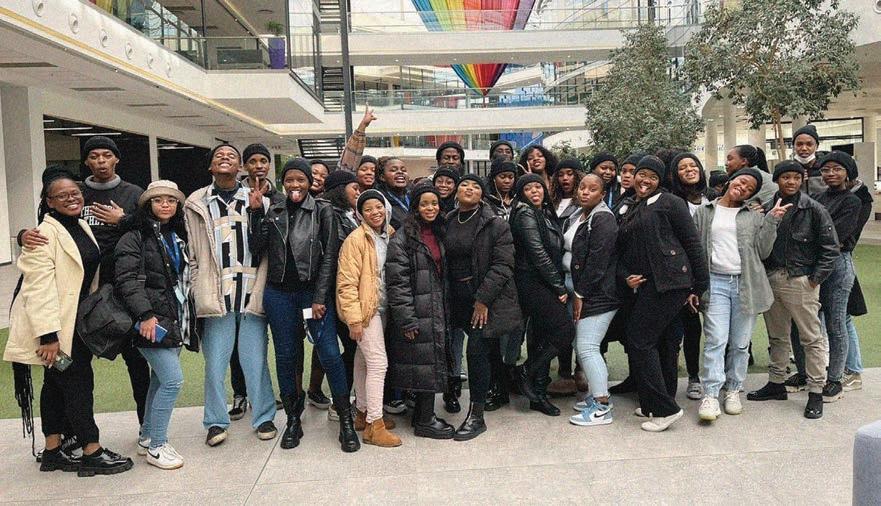
THE AFRIZAN WAY ENTAILS A COMMITMENT TO FINDING THE PERFECT FIT, CULTIVATING POTENTIAL AND BRIDGING THE GAP BETWEEN TALENT AND OPPORTUNITY.
Our RaaS offering has turned the well-known agency fee model on its head where clients outsource their recruitment function or parts thereof for a xed subscription fee. RaaS is suitable for high-churn areas such as call centres, banking branch consultants or retail consultants. Our dedicated consultants pipeline for these roles, enabling a quick turnaround time in these high-churn areas. Both RPO and RaaS enable organisations to optimise their operations by outsourcing talent management to specialists who excel in high-volume and/or scarce-skill talent mobility. This strategic approach not only saves costs and time, but also reduces the need for extensive internal teams and
operational enhancements. By entrusting recruitment functions to RPO and RaaS providers, organisations can focus on their core business activities while implementing a cost-effective and ef cient way to acquire top talent.
Addressing the skills shortage is essential for fostering business growth and ensuring a prosperous future for South Africa. Without a skilled workforce, recruitment efforts fall short, hindering both organisational success and national development. By investing in skills development, we pave the way for a resilient economy and thriving society and ensure our own business sustainability. Central to the Afrizan ethos is the belief in fostering growth and unlocking potential. We believe in the continuous development of talent at all stages, understanding that growth is a lifelong endeavour. This belief led to the founding of The Afrizan
Academy, a fundamental pillar of our dedication to enhancing skills in South Africa. The Afrizan Academy offers a range of SETA and QCTO-accredited courses, skills programmes, learnerships and experiential learning opportunities.
Through collaborative efforts with training institutions, corporates in South Africa play a crucial role in developing unemployed youth to enhance their employability with the necessary skills to excel in today’s dynamic workforce.
The ultimate goal of The Afrizan Academy and Afrizan People Intelligence collectively is to bridge the gap between talent and opportunity.
Since 2018, we have successfully placed almost 3 000 unemployed youth in experiential learning programmes. Through these initiatives, we not only secure employment for unemployed youth, but also set them on the path to long-term success. Additionally, we facilitate placement at client organisations, ensuring both our clients and candidates ourish in their respective roles.
What sets Afrizan apart is our commitment to dynamic talent mobility. Unlike traditional agencies, we prioritise understanding the evolving needs of our clients and candidates, ensuring seamless matches and long-term success. Our dedication to excellence has earned us international recognition, including prestigious awards for our superior customer service.
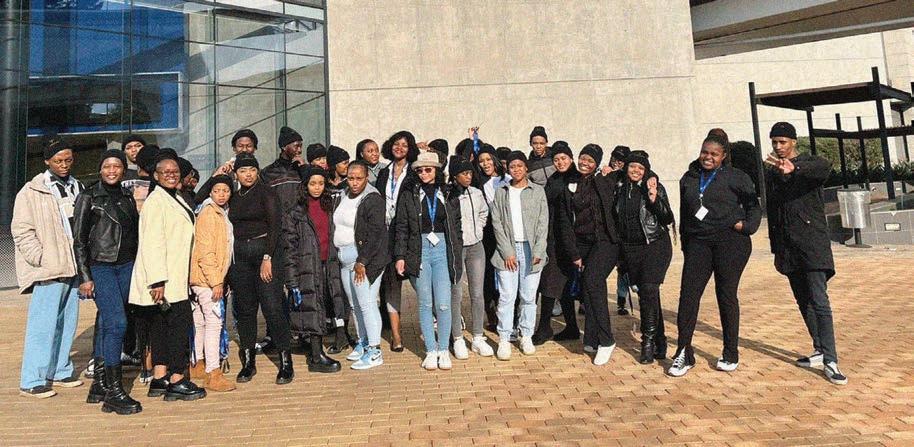
WE BELIEVE IN THE CONTINUOUS DEVELOPMENT OF TALENT AT ALL STAGES, UNDERSTANDING THAT GROWTH IS A LIFELONG ENDEAVOUR.
As we move forward, Afrizan remains committed to pushing the boundaries of talent solutions. Through our innovative approaches and unwavering dedication to our core principles, we aim to continue empowering individuals and transforming businesses.
Beverley Siwisa, Group Executive: Projects at Afrizan, says: “I want to challenge other corporates to join us in turning the tide on youth unemployment and upskilling our talent,
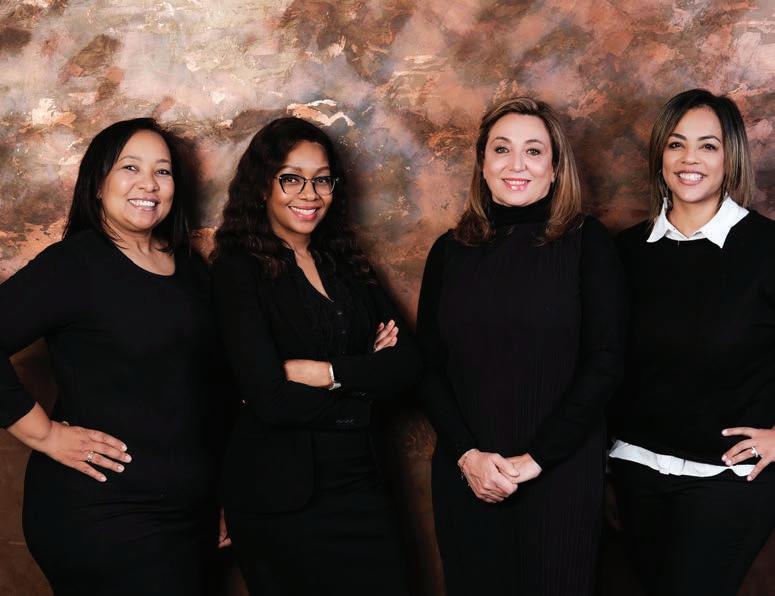
helping to build a sustainable South Africa. If we don’t do it today, what will our future look like tomorrow?”
Partner with Afrizan to embark on a journey of innovation and success where people and technology converge to rede ne the future of talent acquisition.



Over the past three decades, the recruitment industry has shifted from a broadly focused one to an industry offering specialised expertise and tapping into niche markets, writes RODNEY WEIDEMANN

The recruitment industry has undergone a profound transformation over the past 30 years, shaped by technological advancements, evolving business needs and changing candidate expectations.
Three decades ago, job seekers’ most likely source for nding a position matching their skills and aspirations would be through the careful study of newspaper classi ed advertisements. Today, however, the recruitment process is digitalised, with access to potential jobs found across multiple areas, including online job boards, social media platforms and specialised recruitment agencies.
“Thirty years ago, a job would be advertised in a newspaper, several candidates would apply and then be interviewed and appointed,” states Jacques Maritz, national sales and service manager at Quyn International Outsourcing.
“In the modern world, this approach has given way to a more complex and multifaceted process, where hundreds of applications ood in from various platforms, necessitating a rigorous sifting and shortlisting process before interviews can even begin.”
The rise of digital has not only expanded the reach of job postings, but also enabled remote work opportunities, breaking down geographical barriers and allowing companies to tap into a global talent pool.
Pierre Bekker, manager at Quyn International Outsourcing, notes that the rise of remote working has changed things signi cantly.
“Today, an employee would not have to relocate to the city where the job is hosted. Instead, they can work from where they are. This shift has been accelerated by the COVID-19 pandemic, which forced organisations to embrace remote work and re-evaluate their hiring strategies,” he adds.
As businesses have become more digitised and globally interconnected, the skills and qualities sought in candidates have also evolved. Technical pro ciency in digital tools, adaptability, problem-solving skills and effective communication are now considered essential.
“The candidate must be a critical thinker and be adaptable,” says Maritz. “They need good communication skills and must understand cultural difference in the workplace.”
Donna Silver, managing director: permanent recruitment at Afrizan People Intelligence, agrees, noting that when comparing the skills and qualities sought in candidates today with those required last century, a signi cant evolution is evident.
“Employers now prioritise a multifaceted approach, emphasising a diverse range of attributes over and above the technical pro ciency. There’s a big shift and focus on
“THE RISE OF DIGITAL PLATFORMS, THE EMPHASIS ON SPECIALISATION AND THE DEVELOPMENT OF STRATEGIC PARTNERSHIPS HAVE ALL CONTRIBUTED TO A MORE EFFICIENT AND EFFECTIVE RECRUITMENT PROCESS.” – PIERRE BEKKER
your softer skills, such as presentation and communication, paired with technical ability. Additionally, employers place a big focus on agility, adaptability to fast-paced environments and robust problem-solving abilities,” she explains.
“Cultural t has also emerged as a key consideration, with companies seeking candidates who align with their values and can thrive within their unique environment. Recruitment agencies play a crucial role in this process, acting as an extension of their clients and understanding their organisational culture to ensure a good match between candidates and companies.”
While the recruitment industry has made signi cant strides, it also faces new challenges, indicates Bekker. “The demand for remote work and exibility has increased candidate expectations, while diversity and inclusion have become paramount considerations. Additionally, economic uncertainty and skills shortages in certain sectors pose ongoing challenges for both recruiters and employers. “Despite these challenges, the recruitment industry continues to grow and adapt. The rise of digital platforms, the emphasis on specialisation and the development of strategic partnerships have all contributed to a more ef cient and effective recruitment process.”
Pascal Gambale, resourcing executive at Afrizan People Intelligence, points out that over the past 30 years, there has been a total shift in the skillset required from top recruiters. “With scarce and technical positions becoming increasingly paramount in today’s digital and fast-paced environment, we nd ourselves in a candidate-led market where job seekers have substantial in uence and opportunities,” he says. “Thus, a more candidate-centric recruiter must specialise in being able to attract top talent to be able to move them.” Afrizan, for example, proactively pipelines talent for organisations to ll their future- t roles swiftly, as high-caliber candidates won’t be in the market for long. Additionally, the emphasis on diversity and inclusion in the South African job market adds another layer of importance to the recruitment process. Ensuring a diverse and inclusive workforce is not only a regulatory requirement, but also a key driver of innovation and growth. Overall, the ability to quickly and effectively secure and move top talent, while prioritising diversity and inclusion, is critical in maintaining a competitive edge in today’s market
JODY EISER , talent relationship specialist at digital consulting firm Strider Digital, says no other event in recent history has had as big an effect on the world of work as the COVID-19 pandemic

Four years after the pandemic, trends such as “work from home” and “The Great Resignation” have given rise to other movements such as hybrid working structures and quiet quitting. But what is here to stay and what comes next? In general, in the last year or so, companies that saw large proportions of their staff become chronically disengaged at work or “quietly quit” by doing the bare minimum, have taken great lengths to address these issues. But in xing one problem, another has come back into focus – that is micromanaging.
As a way to ensure employees function fully, managers in businesses worldwide have tackled this challenge by performing constant
EMPLOYEES
check-ins, coupled with extra status meetings and have even implemented new reporting structures that have added an extra level of admin pressure onto all those involved. For many employees, this has felt like a step back from pandemic times, when managers seemed to allow more freedom to work independently and observed a more trust-driven management style.
productivity, hovering managers often do the complete opposite and hurt productivity because they create a force of very unhappy workers.
As a result, employees are increasingly looking to their managers for what is now called “quiet managing”. This sees managers reverting to a more hands-off management style, allowing staff to work freely and to have less time-consuming meetings – this is said to remain for the rest of 2024 and beyond.
Praising employees for a job well done goes hand in hand with quiet managing. Letting people get their work done on their own and to a high level gives them a sense of value. This coupled with a round of thanks from management adds hugely to morale and a sense of self-worth.
Once seen by many businesses as “breaking the rules”, side hustles are now steadily increasing in popularity and becoming more widely accepted by employers. With the global cost of living crisis coupled with South Africa’s unique set of challenges, for example, high interest rates and petrol and electricity price hikes, side hustles are becoming a necessity, not just a nice-to-have.

Jody Eiser
Even if not entirely intentional, managers in many industries took on the position of helicopter boss, but rather than increasing
Initially seen as a young generation initiative, side hustles are now gaining ground across the board. They are even being written into employment contracts. In South Africa, side hustles can be as big as running a full-blown small business or as small as taking on freelance work here and there. But whatever this looks like, it’s crucial that all business owners take note and accept the idea of a side hustle.
Side hustles don’t only empower employees to keep a oat nancially. They also have been proven to keep people motivated and allow them to explore other passions, create more variety in their work and also achieve personal goals such as overseas holidays and further education. Side hustles aren’t going anywhere, so it’s important for business owners to embrace them and, where relevant, inspire them.
KINOLA PATHER, CEO of bespoke customer, incentive and employee rewards company Randgo, shares that in today’s challenging business landscape, staff incentive programmes have emerged as pivotal tools

Business success hinges on employee engagement as much as it does on customer satisfaction, and employee incentives are vital for fostering engagement, rewarding transformation, driving productivity and nurturing individual and organisational growth.
They bring a yin-yang effect to play.
A symbiotic relationship arises between motivated employees who feel that they are recognised and rewarded and companies that see a positive impact on their bottom line and, in turn, plough pro ts back into further incentives. McKinsey quotes real-life examples that show how, when implemented and managed properly, employee incentive programmes can become self-sustaining in terms of costs before the rst incentives are even paid out.
The numbers speak for themselves. Studies show that companies that implement incentive and rewards programmes see an average increase in productivity of 22 per cent (Incentive Research Foundation), while those that use incentives to recognise and reward employees for their contributions and achievements report higher levels of employee
engagement (89 per cent), retention (87 per cent), and loyalty (85 per cent) compared to those that do not use incentives. The Harvard Business Review has found that companies that use incentives to reward employees for meeting speci c goals or targets see an average increase in revenue of 44 per cent
There’s a programme for every business need. There’s no one-size- ts-all approach for employee incentivisation; it’s a diverse spectrum that must be tailored to motivate the targeted group. After all, one company’s structure and strategic objectives are not the same as those of another company. Furthermore, while many perceive incentivisation as being solely geared towards sales teams, the reality is far more expansive. Every individual in an organisation plays a crucial role in driving bottom-line results. From sales representatives to human resources, information technology and nance teams, and everyone in between, each employee or team contributes in their own way to a company’s success. With this in mind, incentives should be tied to outcomes within a team’s grasp rather than distant outcomes.
Incentives tap into proven psychological principles. At its core, incentivisation intertwines behavioural change with reward systems. While research suggests that money isn’t the main motivator, current economic realities underscore its signi cance. But employees don’t just want higher compensation. They also want recognition from leadership for the work they accomplish and opportunities that allow them to improve themselves personally and professionally
Randgo works with clients across the spectrum to develop tailored employee and customer loyalty, reward and incentive programmes designed to impact behaviour and sentiment positively. Sourcing and supplying the physical rewards are just one aspect of what the company offers.
As a first step, it works with clients to assess their needs and goals and then determines the most effective and cost-effective way to achieve these goals. From there, it can provide end-to-end support, including internal marketing services to secure employee buy-in and other specialist functions, such as tech capabilities and operational support.
Randgo’s most important advice is that short-term interventions will not create lasting behavioural change. Sustainable incentive programmes transcend immediate rewards to nurture long-term engagement and the formation of new habits. Whether through financial incentives, recognition schemes, or career development opportunities, employee rewards should – and can – encourage a culture of continuous improvement and achievement.
McKinsey’s insights on the role of financial incentives in transformation


How incentives and recognition can improve productivity



In the tough landscape of South African businesses, human resources is a key element for implementing business strategy, and human resource professionals are vital for driving business success, writes INNOVANCE OUTSOURCED BUSINESS SERVICES
Human resources (HR) has a tall order of responsibilities and HR professionals are pivotal in driving business success with strong in uences on growth and nance.
Talent acquisition and retention (used to be hiring and firing).
There is always a person in a role behind everything that happens in a business. South Africa’s exceptionally high unemployment rate provides business with a unique opportunity, not experienced elsewhere in the world. Finding the right talent for your organisation is more than just nding a quali ed individual (someone who can do the job). A job is no longer about can-do attitude; it’s about willdo, want-to-do attitude. When you nd the perfect t, retention is so important. Retention can be achieved through remuneration, opportunities for growth, training, bene ts and a positive workplace culture.
Compliance and legal framework.
Navigating South Africa’s intricate legislative framework requires a meaningful understanding of labour, basic conditions, skills development, employment equity, employee tax (SARS), the unemployment fund, compensation and occupational injuries, bargaining councils, main collective agreements, broad-based
black economic empowerment and unions. Compliance can make or break a business.
Diversity and inclusion.
You can’t succeed in business without considering diversity and inclusion. This is a global phenomenon, which in many cases has been spurred on by South Africa’s post-apartheid “rainbow nation”. Inclusion is not only about males and females; it’s about race and culture, and everything in between and beyond. In business, it is about accepting diversity and harnessing the potential of anybody, regardless of sex, colour or gender.
Embracing technology in your business is a game-changer. Technology is not there to replace your people; it is there to assist the business to reach new heights. Providing your people with strong tools to achieve their successes ef ciently and effectively gives you more capacity in your business to push for greater heights.
HR management systems (HRMS streamline processes such as payroll, bene ts administration and performance management. E-learning platforms facilitate continuous learning and development through online courses and virtual training sessions. It reduces the costs of hiring space and travel and increases focus and knowledge retention.
Business continuity involves implementing strategies and fail-safe practices and ensures no loopholes in your talent and their tasks within the business. Integrating this into your HRMS will leverage your business for further success and sustainability in an ever-changing world.
Human resources in South Africa will continue to evolve, shaped by global trends and local realities. There will be more and more emphasis on:
• Mental health and wellbeing: develop an Employee Value Proposition to enable the business to attract and retain talent while ensuring your existing talent is happy and healthy.
• Sustainability: integrating sustainability into HR practices, promoting green initiatives and encouraging corporate social responsibility.
• Elasticity: mould is old and staid. Elasticity allows business to go out of shape where necessary while still maintaining its winning structure.
• Compliance: understand the risks your business faces while embracing tighter controls on legislation and compliance. Human resources is more than a functional necessity; it is a strategic partner in driving business success. By focusing on talent management, compliance, diversity and employee development, HR professionals can unlock the full potential in your business.


Scan to go to the Innovance website

For more information: 011 465 2558/061 540 5367 outsource@innovance.co.za www.innovance.co.za
ROB MAILICH
,CEO of the REDi Holbourne Group, sheds light on the evolving landscape of international executive hiring in an interconnected world
The current era of global connectivity means the dynamics of executive hiring have transcended geographical boundaries, giving rise to a trend known as “Globally Hired”.
As a South African living in the United Kingdom (UK), I’ve been privileged to witness and participate in this evolving paradigm, recognising the power of diversity and adaptability in shaping the future of global executive leadership.
Here, I want to delve into the trends and tactics shaping international executive hiring, providing a distinct viewpoint from the crossroads of my South African heritage and professional experiences in the UK
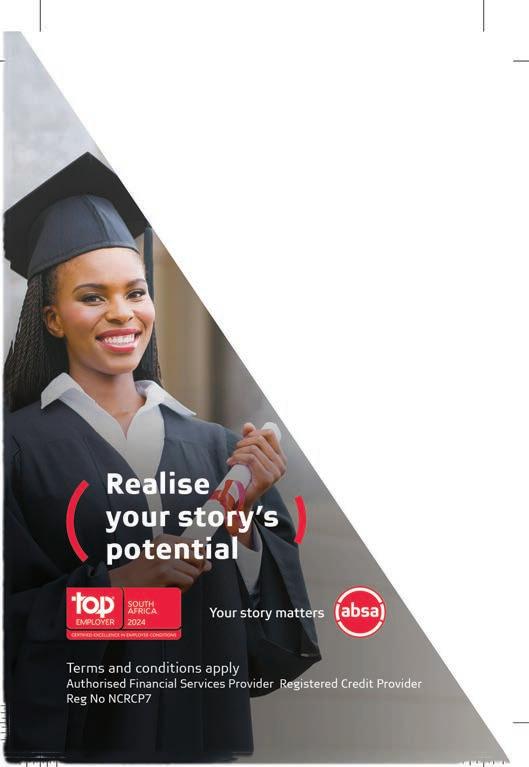

work environment has further accelerated this trend, allowing businesses to tap into diverse talent pools, regardless of their physical locations.
This phenomenon leads to a situation where an individual’s physical presence is in one country, while their intellectual capabilities are employed elsewhere. While this dynamic can enhance a business’s competitiveness in an industry, it raises questions about the sustainability of continuous employee upskilling and promotion. Is this model under threat, or could healthy competition be a positive factor?
Navigating international executive hiring requires a deep understanding of cultural nuances. Being a South African in the UK has underscored the importance of cultural agility – the ability to adapt and thrive in diverse cultural environments. Executives who can transition seamlessly between different cultural contexts are highly sought-after, as they bring a wealth of perspectives and a nuanced approach to problem-solving.
The globalised nature of executive hiring emphasises the signi cance of networking and genuine relationship-building on an international scale.
As a South African professional in the UK, I’ve found that building a robust professional network is instrumental in accessing opportunities and staying abreast of industry trends.
Platforms such as LinkedIn have evolved into indispensable tools for connecting with professionals globally. Additionally, arti cial intelligence (AI) has emerged as a powerful resource, enabling more immediate and sophisticated communication. AI not only facilitates the swift exchange of information, but also enhances the capability to identify and source top talent while predicting future trends for strategic talent pipelining.







SOUTH AFRICANS, KNOWN FOR THEIR MULTICULTURAL BACKGROUND, CAN OFFER UNIQUE SKILL sets, FOSTERING INCLUSIVITY AND EFFECTIVE COLLABORATION IN A GLOBALISED WORK ENVIRONMENT.
 Rob Mailich
Rob Mailich













Executives possessing strong cross-cultural leadership skills are increasingly in demand. This involves not only understanding different cultures, but also leveraging those insights to build cohesive and high-performing teams. South Africans, known for their multicultural background, can offer unique skill sets, fostering inclusivity and effective collaboration in a globalised work environment.
Successfully navigating the international executive hiring landscape involves strategic positioning. Executives must highlight their
global experience, showcase adaptability and emphasise the ability to lead in diverse settings.
Highlighting a diverse skill set and showcasing a track record of success in various cultural contexts can differentiate one in a competitive market. This strategy injects the “X factor” into your professional pro le, showcasing adaptability and a rich depth of experience aligned with the dynamic demands of the global business landscape.
Globally Hired is not just a trend; it’s a paradigm shift in the way organisations source and select their executive leadership. As my business expands its global footprint, I’ve
experienced rst-hand the opportunities and challenges of international executive hiring. In essence, my journey as a South African in the UK has been a testament to the power of embracing change and leveraging diversity.
In turn, sharing our knowledge and implementing best practices throughout our teams enhance our service, empowering our clients and candidates with more sophisticated processes and ideas. This equips them with valuable insights and positions them to stay ahead in an ever-evolving professional landscape as we partner with them to succeed and be resilient in the face of constantly changing dynamics.

Assessing the suitability of a career move requires introspection and evaluation of personal and professional goals.
To consider factors such as alignment with your values, skills and long-term aspirations, it is important to reflect on whether the new opportunity offers growth, learning and fulfillment.
Today’s rapidly evolving job market means that individuals often face the daunting task of making significant career decisions. Whether considering a new job opportunity, exploring a different industry or pursuing further education, navigating one’s next career move can be overwhelming.
Drawing on our extensive experience coaching candidates through recruitment processes and guiding them in exploring their career journey options, we emphasise the significance of addressing these pivotal questions and considerations.
WHAT SHOULD I CONSIDER IN PLANNING FOR MY FUTURE CAREER?
Effective career planning involves a comprehensive analysis of various elements, including industry trends, market demand and individual strengths and weaknesses. Evaluate potential career paths based on factors such as job satisfaction, salary prospects, work-life balance and opportunities for advancement.
Additionally, consider acquiring new skills or certifications to enhance your qualifications and remain competitive in the job market.
MOST IMPORTANT THINGS IN YOUR NEXT CAREER?
WHAT ARE YOU LOOKING FOR IN YOUR NEXT ROLE?
Clarifying the expectations and preferences for your next role is essential for finding a suitable fit. Determine the type of work that excites you, the skills you want to utilise and develop further and the work environment that supports your productivity and wellbeing. In the maze of career choices, navigating wisely is vital. By reflecting on your values, aspirations and the ever-changing job landscape, you can steer towards a path that aligns with your goals and passions.
Keep in mind that clarity and self-awareness are invaluable allies as you plot your path toward your next career step, whether within your current company or in pursuit of a new opportunity.
Changing jobs, companies, colleagues and leaders is a big move, so when deciding if this is what you want, it is important to reflect on the drivers prompting the change. Often the motivation is impulsive and driven by money or emotions. Very rarely are these good reasons for a career change. Have a clear idea of your career path and development goals to navigate the next adventure successfully.
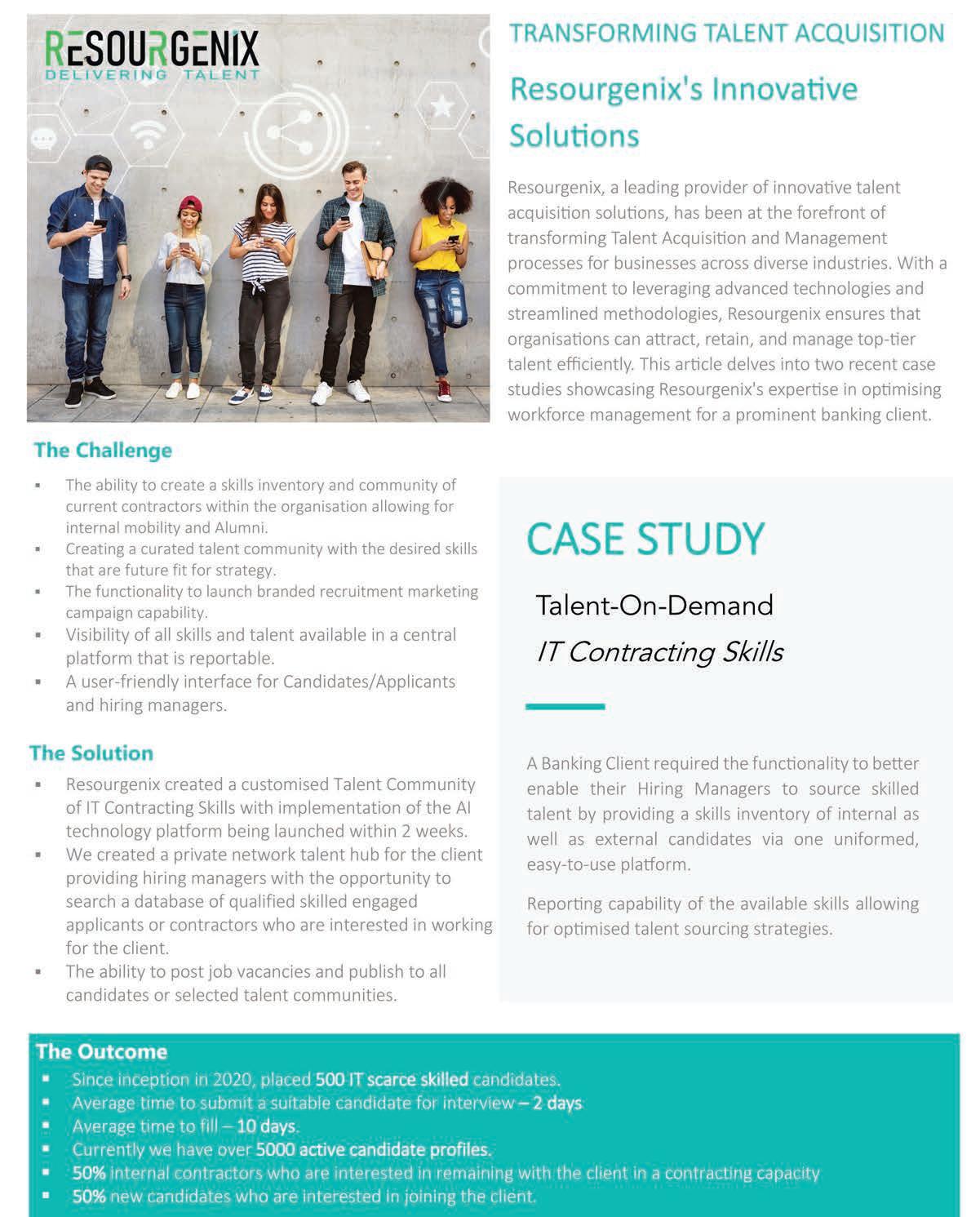

The proposed two-pot retirement
system has caused confusion and anxiety among many employees. Human resources departments need to clarify the situation and prepare employees.
By ITUMELENG MOGAKI
With the two-pot retirement system coming into effect on 1 September 2024, human resources (HR) departments can take several practical steps to prepare their businesses and employees for its implementation as we await its of cial publication. Prabashani Naidoo, chief legal specialist at Liberty Corporate, says the most crucial initial step towards the of cial launch of the two-pot system is understanding its potential impact on employees’ short-term needs and long-term goals.
“Secondly, HR professionals need to understand when employees are eligible to make a claim, the tax implications and what the claim process involves. Employees will likely turn to their HR team for answers to a wide range of questions. Therefore, it’s important that HR is well-equipped to address these inquiries,” she says.
“Given the digital solutions being put in place to handle the expected in ux of savings component withdrawal claims, having complete and accurate member data records is also essential,” Naidoo adds.
She further emphasises the importance of training, noting that training should cover why maintaining accurate information is critical, the processes for updating records regularly and how this data will be used. HR professionals
should also have easy access to resources and collateral that can assist in educating employees. Naidoo also indicates that employees are increasingly asking questions about the two-pot system.
“To help alleviate additional pressure on HR teams, administrators have been communicating with employers and employees about the two-pot retirement system and its potential impacts.
“Ensuring that we have members’ contact details, such as cellphone numbers, email addresses and tax numbers, that are complete, accurate and up to date is crucial. This information must be shared with the fund and administrators,” she states.
Naidoo also highlights the growing signi cance of data: “Currently, communication is conducted through SMS and email. Without up-to-date contact details, members may miss out on regular and informative communications that could help them understand the new two-pot retirement system.
“Member data will be crucial for those wishing to make savings component withdrawal claims as digital solutions will be used and the data will be needed for veri cation purposes. Without this, signi cant delays in processing the vast volume of claims may occur.”
Lindiwe Sebesho, MD of Remchannel, shares the following strategic recommendations and practical steps for HR professionals to implement the two-pot retirement system effectively.
• Automatic transition: the system is designed to be seamless for eligible members, with no immediate action required on their part.
• Withdrawal timing: withdrawals will not necessarily commence immediately on 1 September; system preparations and the usual monthly reconciliations need to take place before members can access the savings pot.
• Not a case of use it or lose it: members have complete control and can access their savings pot at any future time, ensuring that no urgent decisions are needed at the system’s onset.
• Impact on asset performance: the two-pot system categorises funds and does not necessarily change the fund’s investment strategy, supported by Regulation 28, which ensures diversified portfolios.
“Firstly, you must undertake thorough preparation for the transition. Collaborate closely with your company’s retirement fund administrators – provident or pension – to ensure a smooth transition. Clarify guidelines on fund access, relevant forms and how the claims system will operate.
“Enhance nancial literacy by educating employees on the bene ts and structure of the two-pot system, addressing misperceptions. Emphasise the need to consider access as an emergency lastresort option and stress the importance of preserving their retirement savings.”
In addition, there should be an internal marketing communication campaign where organisations develop a targeted communication strategy for all employees. They should offer nancial counselling or coaching, especially for employees over 55, who will not have 10 per cent of their savings automatically allocated to the vested pot, but will choose how to structure their savings within 12 months.
“Strengthen organisational cybersecurity, too, and educate members on phishing threats and encourage regular updates of security settings. Insist they verify communications before withdrawing savings and report suspicious activities,” concludes Sebesho.
“HR PROFESSIONALS NEED TO UNDERSTAND WHEN EMPLOYEES ARE ELIGIBLE TO MAKE A CLAIM, THE TAX IMPLICATIONS AND WHAT THE CLAIM PROCESS INVOLVES.” – PRABASHANI
ELRINA WESSELS, principal strategic clients at Alexforbes, writes that the two-pot retirement system is an opportunity for employers to enhance employee financial stability
The signi cance of an employee’s nancial wellbeing extends beyond personal nances; it directly in uences productivity, job satisfaction and overall health, both mental and physical.
A recent study conducted by Alexforbes at a company with approximately 1 800 employees uncovered startling statistics: employees devote an astonishing 9 372 hours per week to resolving personal nancial matters, with over 40 per cent of the workforce grappling with overwhelming debt. This issue is not isolated to speci c employers or industries; it is estimated that South Africa’s gross domestic product suffers a staggering R235-billion loss annually due to productivity decline resulting from the dire nancial state of households.
The imminent introduction of the two-pot retirement system on 1 September 2024 presents a unique opportunity for human resources departments to bolster employee nancial wellness and education.
In the proposed system, a compulsory two-thirds of retirement fund contributions will be set aside for retirement. This is anticipated to elevate retirement outcomes from the current average of 25–35 per cent to approximately 50 per cent or higher. However, there is ample room for improvement in both short- and long-term nancial outcomes for employees.
Calculations by Alexforbes demonstrate the potential impact of sensible nancial guidance. For instance, consider a 25-year-old employee earning R350 000 annually with unsecured debt (such as a personal loan or credit card) amounting to 35 per cent of their income and a pension fund contribution rate of 15 per cent. With careful planning from an adviser, they could settle their unsecured debt within 2.7 years instead of 5 years.
Additionally, they could save for one child’s tertiary education, have adequate savings left in the savings pot to take as a lump sum, and still achieve a replacement ratio of 65 per cent (of pre-retirement income). Achieving this requires linking contributions to speci c goals. By alleviating unsecured debt, employees could gain an additional disposable income of R3 052 per month – a welcome relief and a barrier against further debt accumulation. Depending on individual circumstances, this solution could complement debt counselling or other debt management options provided by Alexforbes.
International case studies have underscored the effectiveness of nancial wellness programmes in reducing absenteeism and enhancing employee productivity. Addressing nancial stress directly correlates with heightened employee satisfaction.

With short- to medium-term nancial concerns effectively managed, employees may become more receptive to long-term retirement planning. The illustration below is one example of how proper guidance and nancial education can signi cantly improve member outcomes. However, for members closer to retirement who failed to preserve their bene ts in the past, a different approach is necessary.
Contribution levels within the new retirement framework also deserve attention. Considering that contributions will be split in two ways: one-third going towards the savings pot and two-thirds towards the retirement pot, employees, especially those with lower contribution rates, need a clear understanding of the long-term implications.
 Elrina Wessels
Elrina Wessels
Achieving the outcomes illustrated below necessitates a total minimum net contribution rate of 14 per cent. Lower contributions warrant tailored discussions, emphasising preserving the savings pot wherever feasible.
Tailored wellness programmes, encompassing health and nancial education, are instrumental in supporting the holistic growth of employees. Crucially, these programmes should be enhanced by reputable advisory rms offering nancial education and support to employees.
The industry has had several months to grapple with the impact of the new retirement system, it is unrealistic to expect employees to navigate it without continuous, properly structured nancial education.
Employers should partner with a consulting house equipped to provide them with a holistic solution for their employees.
A reputable consulting rm can offer comprehensive guidance on optimising employee bene t designs, ensuring they are future-ready and aligned with the needs of the employees for optimal outcomes.
Investing in employee’s wellbeing translates into investing in the success and longevity of the organisation. Through strategic nancial planning, education and comprehensive wellness initiatives, employers can signi cantly enhance the nancial stability and overall satisfaction of their workforce.


As digital transformation upends industries at an unprecedented pace, the ability to build and nurture an agile, future-ready workforce
has become pivotal for business success, writes BRENDON PETERSEN

Companies that fail to adapt their talent strategies risk rapid obsolescence, while those that harness cutting-edge technologies, such as arti cial intelligence (AI), can gain a decisive competitive edge.
“The importance of workforce management cannot be overstated in today’s dynamic environment,” says Flavia McLean, human resources leader for IBM South Africa.
“Effective employee management is crucial for maximising productivity, optimising resources and achieving organisational goals.”
IBM has been at the vanguard of integrating AI across its human resources (HR) operations. In 2021, it deployed AskHR, an AI-driven platform that automates workforce data gathering and planning across multiple systems.
AskHR has automated over 100 processes and handled 94 per cent of IBM’s global HR queries.
“As AskHR continues learning, employees save time on repetitive tasks to focus on more strategic priorities,” McLean notes. “The platform provides personalised information and even nudges employees with tailored alerts and guidance.”
This injection of AI-powered intelligence and automation is unlocking new potential for
HR to drive impactful change. “Emerging AI tools free HR teams to think more strategically – shaping culture, designing workforce plans and identifying future roles and skills,” says McLean. “This transition directly impacts HR, as companies create new augmented roles and workers take on expanded responsibilities.”
The impact of AI on workforce management extends beyond task automation. By infusing advanced analytics, predictive modelling and prescriptive insights, AI is transforming workforce planning into a precise, data-driven science.
“AI enables us to analyse massive datasets on employee performance, skills inventories, career trajectories and projected business needs to identify gaps and prescribe targeted solutions. This analytical muscle becomes vital as skills grow obsolete faster than ever before,” says McLean.
A recent IBM study found that 120 million workers in the world’s 12 largest economies may need to be reskilled or upskilled, due to AI and intelligent automation, over the next three years. McKinsey research estimates that 14 per cent of the global workforce will need
As remote work booms globally, the “gig economy” of flexible independent labour is rapidly evolving. South Africa aims to be at the forefront by introducing a digital nomad visa to attract remote workers worldwide.
However, Mvelo Hlophe, CEO at Zaio, says: “As South Africa becomes a hotspot for remote work with the new digital nomad visa, we need to think about the big-picture impact of this development.”
An influx of higher-earning digital nomads could displace local coding talent by driving up living costs. Balancing the economic opportunities with the need to protect local workforces will be key, as South Africa positions itself as a global remote work hub.

to switch occupational categories due to automation and AI’s disruptive impact.
This accelerating pace of skills depreciation is why IBM has made AI-driven talent intelligence a cornerstone of its workforce strategy.
“By leveraging AI’s predictive capabilities, we can foresee emerging skill gaps while there is still time to develop and retain the speci c capabilities needed to execute our business strategy,” McLean states.
Combining skills supply forecasts with demand predictions allows IBM to take a proactive approach to workforce planning. Instead of desperately trying to hire or reskill for newly emerging roles when they are already mission-critical, AI enables them to get ahead of the curve.
“THERE’S A GLOBAL SHORTAGE OF AI SKILLS, RELATIVE TO DEMAND. COMPANIES FACE TOUGH DECISIONS AROUND DEVELOPING AI CAPABILITIES IN-HOUSE THROUGH TRAINING OR LOOKING TO OUTSOURCED OPTIONS.” – JJ MILNER
Proactive workforce planning powered by AI also allows IBM to implement “skills recycling” at scale. Rather than hiring new employees for emerging roles, IBM rst explores how existing personnel could be upskilled and mobilised to meet evolving needs. AI models map individuals’ current competencies to forecasted requirements, charting tailored reskilling pathways. The result is stronger skills alignment, improved talent mobility and retention and less disruptive turnover.
The technology is also revolutionising how IBM nds and keeps top talent.
“AI applications enable us to acquire and develop capabilities in lockstep with evolving market needs,” says McLean. IBM’s Watson Candidate Assistant, for instance, enhances recruiting with intelligent chatbots that facilitate real-time candidate engagement for deeper mutual understanding and better role matching.
“The richer information applicants receive leads to a stronger job t,” McLean states. “This helps us identify individuals whose skills align with our talent strategy.”
Once top talent is on-boarded, IBM uses AI-driven learning tools to nurture continuous upskilling and meet strict internal talent mobilisation metrics. “People now expect personalised career experiences, tailored development opportunities that work for their goals,” McLean says. “AI analytics provide those individualised insights while fostering a culture of perpetual learning responsive to change.”
As artificial intelligence (AI) and other technologies reshape industries, companies can no longer rely solely on traditional hiring practices; they must adopt skills-based hiring models.
“AI is helping enterprises rethink talent acquisition,” says Flavia McLean, human resources leader for IBM South Africa.
By leveraging AI to identify candidates with the right capabilities, organisations can build future-proof workforces armed with the exact skills needed to drive innovation and growth.

AI-powered professional development also creates an encompassing employee experience, mapping each person’s capabilities and aspirations to opportunities for growth, mentorship, gig project work, talent cohorts, and more. This holistic approach empowers people to navigate their career trajectories while providing the organisation with an evolving skills inventory primed for potential pivots.
As the workforce transitions accelerate, HR’s ability to deploy AI judiciously will be critical, says JJ Milner, managing director of Global Micro. “AI is infusing business work ows to enhance productivity, with tools such as Microsoft’s Copilot leading the charge. But AI is still a tool – companies need skilled people who understand how to leverage it effectively.”
This creates challenges around accessing AI expertise. “There’s a global shortage of AI skills, relative to demand,” Milner explains. “Companies face tough decisions around developing AI capabilities in-house through training or looking to outsourced options.”
Both paths have pros and cons. Building internal AI pro ciency future-proofs capabilities, but requires signi cant investment. Outsourcing to the gig economy provides exibility, but adds costs and risks around contractor availability. “It can become expensive, as companies compete for the best freelance AI talent, with no long-term allegiance,” Milner cautions.
To help navigate this dilemma, Global Micro positions itself as a trusted partner for AI workforce enablement. “We give small- and medium-sized businesses access to deep AI expertise to unlock the full value of tools such as Copilot,” says Milner. “This enables AI adoption while protecting against risks such as over-reliance on third-party contractors.”
According to the 2023 World Economic Forum Future of Jobs Report, employers estimate 44 per cent of workers’ skills will need to be updated by 2027 to keep pace with disruption driven by technology adoption and economic trends.
Micro partners with clients to implement robust AI governance frameworks covering aspects such as bias testing, data privacy, transparency and human oversight.
Throughout this workforce revolution, HR will need to evolve into a new, more dynamic and tech-savvy role, claim both IBM and Global Micro. No longer just custodians of processes and policies, HR leaders will be strategic workforce architects – blending human insights with AI’s analytical prowess to design future-focused talent strategies.
This transformation is already underway at forward-thinking enterprises. At IBM, the HR team partners closely with data scientists and AI developers to continuously re ne and expand AskHR’s cognitive capabilities. McLean envisions AskHR evolving into a
Global Micro’s approach provides a crucial layer of strategy, security and continuity around AI workforce deployments. “We take a holistic view that extends beyond just technology implementation,” Milner explains. “Our experts help companies plan complete AI workforce enablement roadmaps, aligned to their goals.” This ensures investments in AI skills development produce optimal, lasting returns.
Just as crucial is Global Micro’s role as an independent arbiter of AI governance. Milner says: “With AI’s potential to signi cantly impact people’s careers and livelihoods, it’s vital that workforce AI deployments are ethical, secure and aligned with clearly de ned corporate values.” Global




Digital technologies impact the various workforce generations differently, but the judicious application of these by human resources can lead to much better staff alignment,
writes RODNEY WEIDEMANN

Digital transformation continues to impact businesses, with the integration of advanced technologies increasingly seen as a driver of organisational success. One of the key business areas positively impacted by the adoption of digital tools and platforms is human resources (HR).
For example, digitisation has streamlined HR processes, improving areas such as talent acquisition, performance management, learning and development and employee engagement. After all, the effective leveraging of data-driven insights allows the HR department to enhance workforce productivity, identify skill gaps and predict future talent needs while digital tools enable personalised employee experiences, boosting both job satisfaction and retention.

When it comes to digitisation of the workplace, suggests Andrew Solomon, client strategy director at Achievement Awards Group, it’s really about the
different generations in the workplace. When technology comes into play, he explains, it is inevitably the younger generations that are more prepared to use technology as they are essentially digital natives.
RECOGNITION, REWARD AND GAMIFICATION
“From an HR perspective, this means employees have certain expectations that have been learned through exposure to social media platforms, notably the idea that everything shared is public. Therefore, if an employee receives credit for a job well done, this needs to be delivered in front of everyone,” he says.
“This is why today we have management systems that encompass recognition, allowing the business to thank people – either as teams or individuals – using a system that ensures instances of recognition are undertaken automatically by the system software.”
He adds that this also plays into another change as the newer generations in the
workforce expect more recognition than simply an end-of-year bonus, for example. They expect instantaneous recognition and reward instead.
“This is where gami cation comes into play – it enables immediate feedback and rapid reward. Recognition systems like the one we use have rewards built into them, meaning the company using it can provide constructive feedback and recognise and reward employees consistently throughout the year.
“Moreover, the rewards in a gami cation system are both intrinsic and extrinsic; there are physical rewards, such as bonuses, increases, gifts and vouchers, but there are also social aspects to the rewards. Remember, the newer generations don’t only desire nancial gain, they also want to feel good, to be part of a community that aligns with their values and to receive recognition among their peers. Gami cation allows for this alignment between the organisation and the people it employs.”
Solomon also suggests that hybrid work is proving to be an interesting challenge. While the younger employees are quite comfortable with it, older generations still struggle with not having the face-to-face contact with staff they have been used to throughout their careers.
“Once again, we have solutions such as Slack, which ultimately provide a virtual experience similar to being in the of ce. Younger employees are quite comfortable working with this, however, older staff, who generally make up the bulk of management, struggle with these technologies. Digital transformation is clearly the future, thus, HR must provide training to senior employees less au fait with how such technologies work.
“Truly embracing digital technology means HR has to take responsibility for bringing the managers along for the ride, and fortunately, digitisation can help here, too – workforce management and e-learning tools can play a key role in ensuring proper training and alignment across the entire workforce, whatever generation they are,” concludes Solomon.
“TODAY WE HAVE MANAGEMENT SYSTEMS THAT ENCOMPASS RECOGNITION, ALLOWING THE BUSINESS TO THANK PEOPLE – EITHER AS TEAMS OR INDIVIDUALS – USING A SYSTEM THAT ENSURES INSTANCES OF RECOGNITION ARE UNDERTAKEN AUTOMATICALLY.” – ANDREW SOLOMON
Social media platforms offer employers a different view into the lives of their potential employees. The question is how ethical is it to examine such posts as part of the hiring process, asks BENJAMIN VAN DER VEEN

More than half of the world currently uses social media and social media platforms. A study conducted in May 2024, by Smart Insights Digital Marketing, found that 5.07 billion people (62.6 per cent) make use of various social media platforms for both personal and business purposes.
Out of these 5.07 billion social media users, South Africa currently has 26 million active social media users, with 51.9 per cent of all users within the country using social media platforms for work-related activities, networking or research. South Africa has some of the most active users who leverage social media platforms for work-related reasons.
The intersection of social media and the workplace raises two intriguing ethical questions. Is it morally justi able for potential employers to examine a prospective employee’s social media posts as part of the hiring process? How should human resource departments handle disgruntled employees using social media to criticise the organisation publicly?
Social media has revolutionised how we communicate, connect and share information. For employers, it offers a window into the lives of potential and current employees. But is it ethical for human resources (HR)
professionals to use social media posts as a factor in hiring decisions?
In a recent webinar discussing the pitfalls and potential of how to use social media screening in human resources and recruitment legally and ethically, experts voiced how companies and individuals should comply with existing laws and the Constitution of South Africa.
Referring to this webinar, Farhad Bhyat, co-founder and CEO of media screening and auditing specialist Farosian, says people use freedom of speech as justi cation for their social media activity. “There is a ne line between freedom of speech and infringing a person’s human rights and dignity, which is a criminal act in South Africa,” he explains.
Adding to Bhyat’s thoughts, Lance Katz, founder and CEO of risk management rm Intellivet, notes: “Recruiters can easily spot behavioural traits, such as anti-social conduct, aggression or even racism, by how candidates engage in online groups.”
Bhyat suggests you are drawing data subconsciously when scrolling through a candidate’s social media accounts and are making a decision. “This is happening from
both sides of the coin, where the candidate becomes more knowledgeable about their potential employer and the employer gets real-life insights of the potential hire.”
Social media screening has become commonplace in the South African hiring landscape. A 2023 survey by CareerJunction found that 75 per cent of South African companies use social media to research job candidates. The appeal is clear: it’s a quick, easy and often free way to gain insights into a candidate’s personality, interests and potential red ags. However, the practice raises signi cant ethical concerns.
While no speci c laws govern social media screening in South Africa, several legal and ethical principles can guide HR professionals.
• Transparency: inform candidates that their social media pro les may be reviewed.
• Relevance: only consider information relevant to the job requirements.
• Objectivity: avoid making assumptions based on limited information.
• Fairness: give candidates a chance to explain any potentially concerning posts.
• Con dentiality: keep any information obtained con dential.
The ip side is employees using social media to air grievances about their employers. While employees have a right to free speech, they also have a duty of loyalty to their employer. HR should not treat disgruntled employees as a lost cause. Instead, they should have a step-by-step plan to avoid this happening in the rst place and nd a solution if the employee is already unhappy. In conclusion, disgruntled employees can be costly to the organisation’s performance and workplace culture. Therefore, HR should engage with them to identify the root cause of their dissatisfaction and propose solutions. By managing these issues, companies can improve productivity, prevent toxic work environments and boost employee motivation and engagement.
“RECRUITERS CAN EASILY SPOT BEHAVIOURAL TRAITS, SUCH AS ANTI-SOCIAL CONDUCT, AGGRESSION OR EVEN RACISM, BY HOW CANDIDATES ENGAGE IN ONLINE GROUPS.” – FARHAD BHYAT


EVELYN VANASSCHE, head of recruitment at Teleresources, shares that as the telecommunications space evolves rapidly and the skills required are in global demand, it can be challenging for telecommunications companies to identify and attract the right talent
Keeping pace with an ever-evolving industry means internal upskilling within the telecommunications sector is critical, but this, in turn, can only be achieved with the right people in place. Hiring the best candidates who match the skills required for the industry and can pass their knowledge down through your organisation has become essential for telecommunications companies that do not wish to be left behind.
The telecommunications space is a highly niche market – it is incredibly specialised and critical to many elements of modern life, frequently forming the backbone of a business. For example, cloud-based productivity solutions require network connectivity and access to bre, while mobile phones are integral for business and personal reasons.
In this fast-paced environment, becoming a global player means you need a variety of skills – from 5G to satellite and beyond. In an industry that is all about speed and ef ciency, the better the skills you can identify and hire, the more competitive you are.
However, the reality is that while excellent candidates want to work for the best companies, they will not necessarily knock on their doors. When skills are highly specialised and much in demand, it is necessary to actively recruit the right people for the job, while aligning with the market and their expectations in terms of salary, bene ts and so on.
In-house human resources talent managers may not have the knowledge of the market dynamic, market-related salaries and retention policies they need to nd and attract the skills required. Partnering with a specialist in
telecommunications recruitment means working with a company that is active in nding the exact skills you need, with the platforms and strategies in place to attract the talent and the expertise to ensure appropriate placements.
Recruitment specialists have spent years developing the methodologies, networks, platforms and knowledge they need and understand the telecommunications industry and its history. As the industry changes, they are constantly growing their knowledge base and developing to keep pace with rapid evolution. This is instrumental in identifying relevant candidates.

concepts of mentorship and training down. It is imperative to understand the broader narrative and how one job speaks to another, where the positions t and align. This means you can hire the candidates and empower them to pass on these skills while growing their skill sets as technology evolves. Understanding the bigger picture is key.
The culture of your recruitment agency plays a pivotal role: mediocre recruiters will source mediocre candidates, while those striving for excellence will deliver. A forward-looking view is vital – telecommunications is a constantly shifting global industry, and if you are not innovative, fast and agile enough you will fall by the wayside. Supporting this agility and innovation comes down to the people you hire. This is why it is imperative to partner with a recruitment organisation that truly understands the industry.
Despite South Africa’s alarmingly high unemployment rate, businesses are facing a signi cant hurdle: the shortage of individuals with the required technical expertise, especially in the specialised eld of telecommunications.
The 2021 ICT JCSE-IITPSA Skills Survey shed light on this issue, revealing nearly 10 000 vacant positions within South Africa’s ICT sector. This indicates a substantial lack of technical skills to ful l business needs. Adding to the complexity, the 2022 report highlighted a growing trend among South African companies turning to overseas recruitment to bridge this skills gap. This highlights the need for internal mentorship and training down.
While the country’s president acknowledges the skills gap, the the so-called “digital nomad” visa is not the solution. There is a lack of training and mentoring; and while we do not need overseas skills to teach local talent, we do need to promote and encourage the
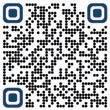




















DLAMINI, regional director at Workforce Staffing, writes that citrus farmers should rely on external service providers to handle admin and staffing requirements, leaving them free to focus on farming
The South African citrus industry grapples with numerous challenges, including logistical issues around the timing of harvests and moving products timeously through the value chain, international regulations and changing weather. Added to these is the introduction of a new national minimum wage, which signi cantly impacts agricultural input costs and can negatively impact pro tability if not handled effectively.
Agility is critical and a strategic approach is necessary when it comes to ensuring cost effectiveness while managing labour requirements. A temporary employment services (TES) partner can be an asset, handling the admin and giving citrus farmers access to a exible, legally compliant workforce that can be available at short notice.













































Like all produce farmers, the citrus sector must deal with the challenges presented by the weather and shifting growing and harvest seasons. Unseasonal rains and turbulent weather, including incidents of ooding, have become more common, making it tricky to know when labour will be required for harvesting.
In South Africa, we also face challenges around community relations issues and logistics throughout the value chain. From picking and packing to moving the product through to its nal destination, bottlenecks and factors outside of farmers’ control can have a negative impact.


The new national minimum wage puts farmers under added pressure, especially when considering the increased cost of electricity. However, it is the law, and it must be followed, along with regulations around the hiring of foreign nationals. The Department of Labour is also cracking down on the employment of illegal migrant workers, so farmers must ensure they are fully compliant.

Partnering with the right TES provider is an effective way of optimising costs and delivering the exible workforce needed while maintaining good community relations. A TES partner should be fully aware of the compliance burden on farmers, including labour, safety and sanitary laws and fair trade regulations. This will provide the exibility to scale and descale the workforce quickly while remaining compliant – a major bene t and competitive advantage.
We are increasingly seeing that fruit is ready to be picked sooner than expected. The ability to source and supply skilled, compliant and experienced labour at short notice is essential to take advantage of this small window. Once the harvest is over, the workforce can be scaled back again to optimise costs.
A TES will handle the administrative burden of managing a large seasonal labour force, including background checks, site training and induction as well as human resources and industrial relations, tax, labour compliance and more.





The nature of the industry means that farmers must pick the fruit at exactly the right time and get it through the value chain on time. Any disruption or delay is detrimental. To handle these challenges, farmers need to be adaptable and have exibility and effective business continuity planning in place. Part of this planning includes labour management.










An added advantage to working with a reputable TES partner is their ability to engage with communities and community leaders to ensure open lines of communication – essential for maintaining good community relations.
A TES is a contributor to pro tability, ensuring exible, compliant staf ng while helping to foster stable community engagement and relations.
DONNÉ NIEMAN, sales director (Western Cape) at Workforce
Staffing, writes that hospitality and tourism businesses can benefit from having a flexible, seasonal workforce, facilitated by temporary employment services providers
As South Africa’s hospitality and tourism industry recovers from the devastating effects of the pandemic, we are once again seeing a shift towards direct hiring and greater full-time staff complements.
While this trend underscores the resilience of the industry, the reality is that it is still volatile and subject to the in uence of multiple external factors, including ongoing load shedding. Reputable temporary employment services (TES) providers can be valuable strategic partners in helping businesses within the sector deal with seasonal and other demand uctuations while improving operational ef ciency and cost-effectiveness.
COVID-19 highlighted the vulnerability of the hospitality and tourism sector, but it is not the only external factor that can in uence businesses in this industry. For example, recent delays in ships entering harbours in both Durban and Cape Town affect the industry in those areas.
International travel still has not returned to pre-pandemic levels, although it is increasing. Ongoing economic pressures mean locals have less disposable income to spend on holidays and meals at restaurants. In addition, load shedding negatively impacts the ability of many businesses to continue operations as normal.
The effects of the pandemic showed that a permanent workforce in the hospitality and tourism sector can be a liability when demand is low. Even without external in uence, tourism is heavily seasonal, meaning it is not best suited to permanent staf ng in general. A TES partner can assist employers
and those seeking employment, giving employees entry into the job market and the opportunity to gain skills and experience while helping employers source the exible workforce they need to handle uctuating demand.
A exible workforce can help hospitality and tourism businesses access the necessary skills to support operational requirements, but without the overheads permanent employment brings. Staff can be scaled up or down to cater to uctuating demand, but with reduced risk and enhanced agility.

The right TES partner can deliver this flexibility, enabling hospitality and tourism businesses to enhance operational efficiency and reduce overheads by reducing the administrative component associated with sourcing and hiring skilled, experienced staff.
In addition, TES can help ensure that businesses recruit appropriate skills
A FLEXIBLE WORKFORCE CAN HELP HOSPITALITY AND TOURISM BUSINESSES ACCESS THE NECESSARY SKILLS TO SUPPORT OPERATIONAL REQUIREMENTS, BUT WITHOUT THE OVERHEADS PERMANENT EMPLOYMENT BRINGS.
through transparent processes. This is delivered alongside rigorous vetting processes and clear communication channels while remaining compliant with relevant labour legislation.
Partnering with a reputable and compliant TES ensures hospitality and tourism businesses can leverage the exibility needed to adapt to changing needs, seasons and market conditions.
South Africa faces ongoing uncertainty and unpredictability, which further reinforces the need to maintain a exible workforce.
A TES partner with the right credentials from a compliance, labour legislation and skills perspective and the ability to deliver skilled staff on demand is instrumental in helping businesses handle the challenges of today’s environment and any future impacts.

Nestlé is the world’s largest food and beverage company. It is present in 187 countries around the world. The company’s 291 000 employees are committed to Nestlé’s purpose of unlocking the power of food to enhance quality for everyone, today and for the generations to come.
In August 2018, we formed a new region known as the Nestlé East and Southern Africa Region (ESAR), comprising 23 countries, namely: South Africa, Botswana, Namibia, Lesotho, Mauritius, Zimbabwe, Zambia, eSwatini, Kenya, Mozambique, Tanzania, Comoros, Madagascar, Seychelles, Burundi, Rwanda, Somalia, Ethiopia, Uganda, Malawi, South Sudan, Eritrea and Djibouti.

The ESAR region employs 3 200 employees. Operationally, we have seven Nestlé factories across ESAR, located as follows: South Africa ( ve), Zimbabwe (one) and Kenya (one).
In most of the countries where Nestlé operates, there is a plethora of socio-economic challenges, including the triple burden of disease: obesity, micronutrient de ciencies and undernutrition. To respond to these challenges, we bring our purpose to life through our Creating Shared Value business approach. Creating Shared Value is our way of delivering long-term positive impact for our shareholders and society.
Employees are committed to Nestlé’s purpose of unlocking the power of food to enhance quality for everyone, today and for the generations to come.


The requirements for gender equality in the private and public sectors are outlined by the Employment Equity Act. THANDO PATO speaks to experts to learn the strategies human resources teams should be implementing to ensure they are compliant
Portia Thokoane, human resources director, Nestlé East & Southern Africa, admits there is a gap between expectations and reality in gender parity in South African organisations. Thokoane says to overcome the disparity and make headway, leadership in all spheres of an organisation needs to throw its weight behind diversity and inclusion – it is not just a human resources (HR) function.
Javu Baloyi, spokesperson for the Commission of Gender Equality (CGE), agrees: “Gender equality is an organisational obligation. At the CGE, we have often observed that when an organisation fails to include transformation in managers’ performance agreements, it hinders transformation and gender equality.”
Baloyi says that under the Employment Equity Act (EEA), organisations should have an employment equity manager – usually designated as a transformation manager or executive – who works alongside senior leaders to formulate and implement a transformation roadmap, one that includes gender transformation.

“When an
organisation
Gender representation on the boards of the top 40 JSE-listed companies.
• Women make up 35 per cent of the board of JSE-listed companies and 25 per cent of executive roles.
• The Bidvest Group is the only company in the top 40 with gender parity at board and executive level: 75 per cent female representation at board and 50 per cent at executive level.
• Only five chairpersons of the top 40 company boards are women: Anglo Gold Ashanti, Capitec Bank Holdings, Impala Platinum Holdings, Shoprite Holdings and the Standard Bank Group.
• Only four top 40 companies have a woman CEO: Anglo American Platinum, Bidvest Group, Clicks Group and Exxaro Resources.
Source: Women in leadership: Assessing gender equality in the JSE Top 40.
Baloyi adds that women are currently under-represented at top and senior management levels in the private and public sectors. He explains that the challenges often facing HR departments in meeting targets are the lack of policies or, in some cases, outdated policies, along with ill-equipped HR of cials who have not received training on gender equality and all the policies surrounding it.
Thokoane says Nestlé’s approach towards gender parity at all levels of the organisation includes consistent tracking of key performance
fails to include transformation

indicators related to female representation in leadership positions, training on unconscious bias and sexual harassment prevention and implementation of parental support policies.
“We also promote af nity networks with senior leadership sponsorship drive initiatives, focused on creating a more inclusive culture for various groups of employees. Nestlé’s Gender Balance Acceleration Plan aims to increase the proportion of women in top senior executive posts.
“We carefully monitor succession planning to ensure a pipeline for critical business roles and provide career support and guidance through our Senior Leader Development Roadmap. Through these comprehensive approaches, we demonstrate our commitment to fostering a diverse, inclusive and equitable workplace
in managers’ performance agreements, it
hinders transformation
and gender equality.” –
Javu Baloyi
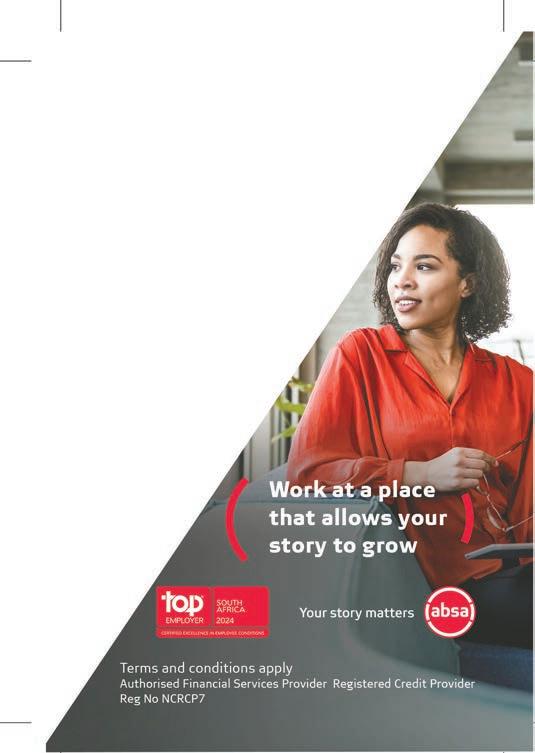
No longer is a promotion and a bigger pay cheque a guarantee that your top talent will remain loyal to your organisation. So, what is, asks LISA WITEPSKI

Today’s employees choose their workplace according to different criteria than their predecessors. In the past, the key questions were: what is my career path? What opportunities are there for advancement? How can I get ahead?
Fast forward a few years and the factors attracting an employee have broadened, so an employer value proposition has to take into account issues beyond self-advancement. Obviously, career satisfaction remains key – but people are no longer prepared to allow this to come at the expense of personal wellbeing.
An article on Hrgrapevine.com reveals that 61 per cent of staff are ready to leave a job if they feel it affects their mental wellbeing. They also demand greater exibility – a hangover from the work-from-home days of the pandemic. To ensure they can do so, or to do their jobs ef ciently, they prefer workplaces that are quick to embrace enabling technologies.
“CREATING
Although issues such as company culture and recognition are important to them, they are also interested in how the company treats its larger communities. The Hrgrapevine article states that 70 per cent of employees do not want to work for a company that does not have demonstrably strong values.
Against this backdrop, Desiré Pauw, executive: human capital at Momentum Investments, says: “To understand how you nurture loyalty in times of change, you must rst understand that loyalty does not equate to one’s tenure or having a meaningful job. If you think about those employees who go beyond what is expected of them to leave a lasting impression on your clients and set up your business for success, they typically have certain things in common.
“These include a strong emotional bond with your business, an understanding of the
organisation’s purpose and their personal purpose and how this aligns with what you want to achieve and meaningful work that helps you deliver on your purpose.” She adds that creating lasting loyalty hinges on fostering a culture that drives an exceptional employee experience.
That’s no small task, but it helps to have constant employee engagement and interactions that build a solid foundation of trust, Pauw says. “If employees trust your intent and know you have their best interests at heart – and your track record shows this to be true –they will continue to be loyal even in the face of signi cant change.”
Michael Gullan, CEO of G&G Advocacy, agrees that culture is critical, adding that supportive, collaborative cultures are most effective for retention. One way of achieving such an environment is by encouraging mentorship and exposure to exciting opportunities that stretch employees’ skills and to senior members of the organisation.
This approach is embraced by John Skelton, chief people of cer at The Capital Hotel Group. He explains that the employee of the month has a sit-down breakfast with the CEO to discuss the business. The company has further addressed issues such as quiet quitting by introducing unlimited leave, an employee self-service system and free training without clawbacks.
Training is a serious issue, continues Gullan. Employees want to know the content they receive is of the best quality, easily applied to their everyday situations and delivered through exible, engaging training sessions. “Above all, you must meet employees where they are. You have to understand that today’s workplace is made up of different generations with different expectations and needs, and address them accordingly.”
Inclusivity has also been shown to enhance loyalty and employee engagement, says Jeremy Bossenger of BossJansen Executive Search.
“While we are accustomed to thinking about this in terms of race, age and gender, companies that make accommodations for neurodivergence reap signi cant rewards – actions such as offering noise-cancelling headphones, reinforcing workplace etiquette and giving advance notice of changes to tasks and roles can go a long way in this regard,” he concludes.
